2023.3.x INSYDIUM Fused Perpetual License
EDIT in Admin Edit in WP
INSYDIUM's collection of Plug-ins, Products and Benefits
INSYDIUM Fused gives you the ultimate toolkit to create mesmerizing particle effects, realistic terrains, animate plants – and more! With this powerful collection of plugins and products at your disposal plus an array of assets just waiting for you to discover them, there’s no limit to what creative solutions can arise.
The collection is only available if you have INSYDIUM Fused Complete, your perpetual license has Maintenance or you have a Subscription.
INSYDIUM Fused is natively compatible with Apple M1 systems, except Cycles 4D, which cannot be used on these machines as it does not have silicon support.
All INSYDIUM products in one collection
Everything you need to create stunning GPU-accelerated particle effects, plant animations, realistic terrains and fulfil modeling tasks through to the final render. Plus, our Library Assets.
INSYDIUM Fused consists of:
- X-Particles
- NeXus
- Taiao
- TerraformFX
- MeshTools
- Cycles 4D
- Taiao Presets Packs
- Nature Materials Pack
- 360 Skies Pack
- Material Packs
- Architecture Pack
- Cycles 4D Starter Pack
New in Fused 2023.5
X-Particles new features
The new features added to X-Particles make it more powerful than ever. You’ll now be able to generate particles from cached scenes. We’ve added updates to the emitter and added multi-instance support for generators.
You’ll now also be able to generate live particle effects, like spawning and foam, from cached particle scenes. Simply activate an xpSpawn with a spawning emitter, hit play and spawn particles from the position of the cached particles. Upres an xpFluidFlip scene by generating live foam from the cached fluid simulation.
NeXus fluid tools have been updated with this ability, which is interchangeable with X-Particles. In this next update, X-Particle will support multi-instances. Multi-instance mode makes it possible to play heavy scenes and view the animation without issue.
We’ve added a new rotation mode to the xpEmitter to ensure the correct orientation of stuck particles. Activate local rotation for it to work.
To top it all off, we’ve added a spline mesher planer mode, to generate ribbons from xpTrails or any scene spline.
NeXus – Control
NeXus has been updated with some incredibly powerful new tools.
nxQuestion enables the triggering of effects from particle and scene data. Use it to write your own scripts to drive particle effects. You can even use AI generated code!
Although nxQuestion can get incredibly complex, it can be used simply and intuitively, even by beginners. You can infinitely layer up questions and actions in a logical workflow, making complex scenes easier to build and manage. Use fields with nxQuestions to trigger actions. We’ve added a loop layer, meaning particles will return to their original position. Use the fast-calculating particle neighbour search to drive recursive spawning effects and restrict the growth by using an object volume question.
Use nxQuestions script layer to create your own GLSL scripts for bespoke particle effects. Or use ChatGPT to generate code for you. Paste in the pre-prompt instructions to teach the AI how to work with X-Particles and then ask it a question!
The brand-new NeXus Data Mapping system makes it possible for every single modifier and dynamic modifier to be data mapped. Layer up your maps, set parameters and adjust it to your needs.
NeXus – Modifiers
NeXus is more powerful than before, with additional parameters and a whole host of modifiers. Simulate realistic flocks and swarms, create organic particle-growth systems, upres low particle-count caches and design layer-based blending options.
Use nxUpres to upres low count particle simulations. Use the cached emitter as the source and an emitter as the destination with a higher particle count, then hit play for live generated, high-particle count simulations, based on the velocity of the source particles.
xpInfectio is now on the GPU as nxInfectio.
nxWave creates a live velocity field that generates animated waves for fluid simulations. We’ve even added six custom noise types especially for NeXus!
xpFoam is now on NeXus as nxFoam, making art directions quicker and easier.
nxWind has been updated with a Von Karman mode, meaning you can create far more physically accurate gusting for realism in simulations.
Particle to object avoidance is now on the GPU with nxAvoid.
nxFlock gives you the ability to layer up several flocking behaviours, like chaos and cohesion. Create pursuit objects for your particles to chase or create enemy particles for which to flee!
With nxBlend, you can now use several blend modes. There’s a new waiting tab for layer-based waiting per particle emitter, enabling you to create amazing blending effects.
nxQuestion
The concept of Questions and Actions in X-Particles has been entirely revamped, incorporating advanced coding logic into an object-based hierarchy system. This system provides the capability to include loops, GLSL scripts, or simple particle tests, thus elevating the control over particles to a new level.
Data Mapping
The X-Particles Data Mapping concept has been incorporated into a newly redesigned, modern system for NeXus. This system allows you to create custom data maps to control various parts of any NeXus modifier, including constraints and fluids. With this system, you can create effects with simplicity and ease.
nxUpres
New to NeXus, nxUpres lets you work on low-resolution particle scenes, then transfer motion and increase the particle count to a secondary high-resolution nxUpres emitter. You can build a complex scene and have confidence in the final render.
nxInfectio
Create stunning particle growth simulations with the new GPU-enhanced version of the xpInfectio modifier. Use nxInfectio to infect thousands of particles quickly and affect growth patterns. It’s fast, robust and perfect for generating impressive visual effects.
nxWave
Introducing nxWave, the GPU version of the xpWave modifier. Featuring faster GPU noises and adjustable wave height and frequency, catering to all your wave motion requirements.
Taiao new features
Taiao has been stacked out with brand new features providing improvements to artistic workflow, animation, growth effects and realistic forces.
And to round it all off, toFlower is now a stand-alone object with its own procedural layering system. Build your flower with individual flower parts as individual layers.
Growth
The improved growth system provides the ability to animate the growth of each plant layer. Use keyframed leaves, flowers or custom objects, then animate them individually. By setting the leaf trigger mode to sequence, they will animate from the bottom to the top. Alternatively, you can use fields to grow the animated layers of your plant.
Forces
Taiao forces are now fully layer based, with individual control per plant layer. You can adjust the strength of forces along the length of the trunks and branches. Furthermore, you can use fields and the new curl option for leaves to add secondary deformation for more realistic results.
Modifier Stack
Modifier stack is a powerful new tool enhancing Taiao’s toPlant, toLeave, and toFlower. With the per plant layer modifier stack, you can procedurally layer up modifiers like furling, turbulence, displacement and twist, then animate individual layers using fields.
toLeaf
toLeaf is the new procedural leaf generator. Create realistic leaves, ranging from standard to palmate and pinnate. Create vein structures and utilize the modifier stack, layer multiple folds, furling and turbulence for specific looks. Control the look of the profile orientation, distribution and size variation.
TerraformFX new features
tfTrace is a new operator that uses ray tracing to incorporate scene geometry into the TerraformFX height field, making it possible to create custom landscapes with ease.
You can now create procedural river systems with tfRiver. Create them using splines or fully procedural perlin worms. You can also add secondary rivers via branching options, making it possible to create complex river systems.
The addition of tfFormula means you can now use formulas for the generation of abstract animated landscapes. The variables can be adjusted and key framed for different styles.
The new gradient UV Shader allows you even more control over the look and feel of your landscape. Create psychedelic looking landscapes or opt for realism, the choice is yours!
We’ve also added a sunlight rig to the tfTerrain object, meaning you can now adjust the sun’s angle, add shadows, and adjust the ambient light in the viewport.
For good measure, we’ve added 5 preset terrains to get you started!
tfRiver
With the new operator tfRiver, you can create beautiful rivers based on your own custom splines. Alternatively, you can use a fully procedural Perlin worm and attach your river to a landscape by selecting the starting and ending points. The river system is based on layers and will follow the natural terrain for the main rivers. You can also add secondary river systems for complete creative control.
MeshTools – mtSplineFX
mtSplineFX is the new spline effects generation tool, coming to MeshTools. It is perfect for creating forked lightning, designing cabling systems, detailed webbing designs and complex electrical arcing systems.
Connect objects by simply dragging objects into the start and end object properties boxes. Connection objects can be polygon objects, splines and generators, like mograph cloners. You can also connect X-Particles.
mtSplineFX has noise-driven motion control for animated splines with a choice of noises. Simply layer up small noise detail and use the falloff curve to map the effects of the motion along the spline.
Quickly and easily create scene wires and cables, using the animation settings in the growth tab, along with the gravity settings.
You can make connections based on your original connections. You can add fork layers, with adjustments available to the length, length variation and angle of the forks. Falloff can also be used to dictate the noise and distribute it along the splines. Additional forks can be generated from forks by simply adding another layer.
MeshTools – mtRayline
MeshTools Rayline is a procedural ray casting spline generator. Perfect for motion graphics, spline animations, laser effects and more!
Quick and easy to setup. Simply emit rays from an object, add scene objects and the rays will be cast from the emitter and bounce off the scene objects. This will animate and update in real-time.
Cast rays inside the volume of objects or use animated cloners for collisions. You can also setup custom procedural objects to cast rays from.
Combine mtRayline with X-Particles to cast rays from animated particle simulations or combine with X-Particles to create lazer melting effects!
mtRayline
New procedural ray casting spline generator. Choose an object or an X-Particles emitter to cast rays from, add scene objects and the rays will be cast and bounce off that object. This will animate and update in real-time.
mtSplineFX
The new spline effects generation tool is perfect for creating forked lightning, designing cabling systems, detailed webbing designs, and complex electrical arcing systems. Use custom objects or particles to generate splines between the start and end objects, add gravity, growth, motion or avoid for varying effects.
 NeXus
NeXus
Only available as part of the INSYDIUM Fused Collection for Subscriptions, Complete licenses and licenses in Maintenance.
NeXus is a GPU particle and simulation system that integrates perfectly into the X-Particles ecosystem.
Harnessing the power of Vulkan, our cross-platform particle simulation framework brings fluids, grains, constraints and particle modifiers onto the GPU.
nxQuestion
The concept of Questions and Actions in X-Particles has been entirely revamped, incorporating advanced coding logic into an object-based hierarchy system. This system provides the capability to include loops, GLSL scripts, or simple particle tests, thus elevating the control over particles to a new level.
Data Mapping
The X-Particles Data Mapping concept has been incorporated into a newly redesigned, modern system for NeXus. This system allows you to create custom data maps to control various parts of any NeXus modifier, including constraints and fluids. With this system, you can create effects with simplicity and ease.
Fluids and Grains
The NeXus nxFluids solver combines PBD and SPH into one unified toolset. Choose the solver type and have all the control you need. Add the nxFluid tag to any emitter for complete access to your particles and make the fluid grains different densities for all types of fluid effects.
nxConstraints
The updated nxConstraints adds all the constraints into our list UI. You can control the number of connections, radius and breaking point. Select and adjust constraints on the fly to get fast, stunning effects. Dynamic simulations such as cloth fluids and breaking sims are made easy with nxConstraints.
More Key Features
nxUpres
Available in NeXus, nxUpres lets you work on low-resolution particle scenes, then transfer motion and increase the particle count to a secondary high-resolution nxUpres emitter. You can build a complex scene and have confidence in the final render.
nxInfectio
Create stunning particle growth simulations with the GPU-enhanced version of the xpInfectio modifier. Use nxInfectio to infect thousands of particles quickly and affect growth patterns. It’s fast, robust and perfect for generating impressive visual effects.
nxWave
nxWave, the GPU version of the xpWave modifier. Featuring faster GPU noises and adjustable wave height and frequency, catering to all your wave motion requirements.
nxFoam
Enrich your NeXus fluid simulations with foam particles for added realism. This feature enables you to generate foam, trapped air and spray particles on top of your nxFluidPBD and nxFluidFX simulations.
nxModifiers
Bringing in many of the standard modifiers into the NeXus GPU framework. Enabling you to create unique effects with a simple and intuitive workflow aided by layering up modifiers.
nxTurbulence
nxTurbulence brings industry-standard turbulence models into the NeXus framework. You can add simplex, curl, fBm and more for stunning turbulence effects.
GPU
Harnessing the power of Vulkan, our cross-platform solver works with modern NVIDIA, AMD, or Apple M Series GPU with at least 4GB of VRAM, support for Vulkan, sufficient compute capability for advanced GPU tasks, and up-to-date, stable drivers for software compatibility.
 INSYDIUM X-Particles
INSYDIUM X-Particles
X-Particles is a fully-featured advanced particle and VFX system for Maxon’s Cinema 4D. Its unique rule system of Questions and Actions enables complete control over particle simulations.
Why X-Particles?
An essential component of an artist’s toolkit, X-Particles is the solution to satisfy all your particle needs: Cloth, Smoke, Fire, Fluids, Grains and Dynamics. Designers can switch effortlessly between motion graphics and VFX, within a unified system.
ParticleFX
Create outstanding ParticleFX from Solar Systems, FUI, Holograms and medical visualizations to abstract artwork. Multiple options to combine Emitters and Modifiers, gives you a range of possibilities.
Smoke, Fire and Advection
Realistic smoke, fire and explosive simulations. You can export ExplosiaFX as a VDB volume, and any render engine that can read the VDB data can then render the volume data.
Fluids and Grains
Our Liquid and Grain Solvers enable you to create stunning large and small-scale fluid simulations. From gorgeous beaches, with waves and ocean spray, to beautiful product shot splashes.
Dynamics
Stepping closer into the realms of fully dynamic motion design, X-Particles’ DynamicsFX offers the perfect solution to bend and shatter reality for amazing visual effects production.
Cloth
Drive Cloth simulations with any Modifier, then rip it apart with the advanced tearing options. ClothFX adds a whole new dimension to motion design effects and destruction VFX shots.
See the Details Tab for more info
 Taiao
Taiao
Only available as part of the INSYDIUM Fused Collection for Subscriptions, Complete licenses and licenses in Maintenance
Taiao is a procedural plant animation system used to generate trees, flowers, grasses and custom objects.
Create different species of trees and replicate how they fight for light and space with Taiao. Make an array of grasses and flowers. Use layers and rules to drill down and control each element.
Why Taiao?
The Taiao plugin sits perfectly in the INSYDIUM Fused Collection. Taiao enables you to create trees, plants, flowers, grasses and custom objects. Ideal for architectural visualizations, 3D animation and film.
Build individual plants and colonize landscapes, bring animations to life with forces to add natural motion to the plants. Imitate the seasons by adjusting leaf color and distribution. From saplings to 200-year-old oak trees; the possibilities are endless. Recreating nature is made easy with Taiao.
Growth
The improved growth system provides the ability to animate the growth of each plant layer. Use keyframed leaves, flowers or custom objects, then animate them individually. By setting the leaf trigger mode to sequence, they will animate from the bottom to the top. Alternatively, you can use fields to grow the animated layers of your plant.
Forces
Taiao forces are now fully layer based, with individual control per plant layer. You can adjust the strength of forces along the length of the trunks and branches. Furthermore, you can use fields and the curl option for leaves to add secondary deformation for more realistic results.
toLeaf
toLeaf is a procedural leaf generator. Create realistic leaves, ranging from standard to palmate and pinnate. Create vein structures and utilize the modifier stack, layer multiple folds, furling and turbulence for specific looks. Control the look of the profile orientation, distribution and size variation.
Modifier Stack
Modifier stack is a powerful tool enhancing Taiao’s toPlant, toLeave, and toFlower. With the per plant layer modifier stack, you can procedurally layer up modifiers like furling, turbulence, displacement and twist, then animate individual layers using fields.
toPlant
Procedural layered based modeling plant animation system. Build up with layers, trunk, branch, leaf, flowers and custom objects. Each layer is customizable, with great control over shaping, bending and forming.
Unique procedural selectors in every layer provide a convenient workflow to add materials and forces for added realism to your plant. Use toPlant’s own inbuilt hierarchy, delve into individual plant parts or work on sections for precision detailing.
toTree
A simulation-based system creates natural growth based on rules. For example, create a tree using 3D volume objects; your tree will grow within your chosen object’s shape.
Change occurs naturally, using the points to ensure no intersections occur. toTree opens up endless possibilities for design, a perfect accompaniment to X-Particles; use any emitter to create particles that can then become part of your tree. Colonization is easy; create multiple trees, different species, and ages within a landscape.
toGrass
Generates grass on any object to create barren desert-scapes to lush summer meadows. Scatter objects such as rocks as a layer, and you can add trees and shrubs to complete your landscape.
Multi-instance support speeds up the viewport scenes keeping load times quicker and lighter.
More Key Features
Taiao gives you the same power, flexibility and real-time ease-of-use as our other Fused products, so adding natural details and other custom elements is simple.
- Flowers – As part of the Taiao plant system, all flower elements are listed as controllable plant layers. Petal, pistil, stamen, receptacle and sepal can be manipulated to create many natural species, or you can make an abstract flower. Use procedural animation to increase petal counts, rotate, shape and angle as desired.
- Leaves – Shape leaves with splines or add material, change the distribution, and move or scale. Add an emitter and use objects to create realistic abstract forms and customizable random variations scale to leaves. Add thickness and subdivisions for complete control over the leaf shape. Define spline for more details.
- Custom Objects – Use custom objects to create natural-looking fruit or nuts to complete the details in your design. You can add acorns to oak trees, coconuts to palms, or fruit to bushes. Custom objects provide the tools to fine-tune the details on your trees and plants.
Cinema 4D Integration
Cinema 4D users will feel at ease when using Taiao. Like all INSYDIUM Fused Plugins, Taiao fits seamlessly into Cinema 4D where workflow, layers and hierarchy are standard.
Renderers
Taiao is compatible with Cinema 4D Standard Renderer, Cinema 4D Physical Renderer, Cycles 4D, Redshift, Octane and Arnold.
Cycles 4D
Only available as part of the INSYDIUM Fused Collection for Subscriptions, Complete licenses and licenses in Maintenance
Cycles 4D is a dedicated bridge plugin allowing Cinema 4D users to access the Cycles rendering engine directly inside Cinema 4D without the need for an external application.
With INSYDIUM’s own Real-Time Preview window and fully featured Node Editor, along with our eye for detail and quality, Cycles 4D is the ultimate render companion with unparalleled access to all Cinema 4D Modules and superb integration with X-Particles.
Note: Cycles 4D cannot be used on Apple M series as it does not have silicon support. For more information, please go to our Knowledge Base.
Why Cycles 4D?
With INSYDIUM Fused, the challenges of working on a complex 3D scene are made simple.
Assessing the final result of your materials and lighting is easy with the fast and responsive Real-Time preview. Cryptomatte makes separating multiple scene elements fully automatic, saving hours of precious production time.
Cycles 4D, with its flexible nodes based system, means the power and speed of the Cycles render engine is fully accessible within Cinema 4D.
Creating stunning results has never been so easy.
Cinema 4D Integration
Cycles 4D is a complete extension to the Cinema 4D workflow. Access many parts of Cinema 4D directly in the Node Editor, giving you full control over your scene assets. Cycles 4D integrates seamlessly into your working environment. Cycles 4D cannot be used on Apple M1 systems as it does not have silicon support.
Supported Cinema 4D Core Features:
- Cinema 4D Shader Conversion
- Real-Time Preview
- MoGraph Color
- Cloner Instancing
- Render Instancing
- MoGraph Matrix
- Hair
- Texture Baking
- Team Rendering
- Takes & Tokens
- Full X-Presso support for Node Attributes
Key Features
Cycles 4D gives you the features to improve your workflow and productivity. You’ll find fantastic lighting tools for greater control of your lighting rigs, enabling you to create excellent physically correct, realistic results. Our super-efficient Node Editor and smooth, fast Real-Time preview, all create an extensive toolset for 3D Artists.
- Cycles Core 1.13.0
- Sky Texture Nishita Node
- Adaptive Sampling
- Real-Time Denoising
- Shadow Terminator Offset
- Chromatic Aberration post effect
- Volume Object
- Light Presets
 TerraformFX
TerraformFX
Only available as part of the INSYDIUM Fused Collection for Subscriptions, Complete licenses and licenses in Maintenance
TerraformFX is a powerful, art-directable terrain generator used to build highly-customizable landscapes.
Build terrains with ease and create an infinite number of high-resolution landscapes with TerraformFX. Layer noise, shaders, textures, splines and gradients to create mountains, lakes and rivers.
Why TerraformFX?
TerraformFX is fully art-directable; you can add mountains, hills, valleys, and rivers. Adjust and fine-tune using various filters. Choose from multiple blend modes, shaders, and masking options to make your landscape truly unique.
An intuitive and flexible workflow enables you to generate the geometry in almost any resolution.
Being fully multi-threaded means TerraformFX is fast and efficient, making use of all your machine’s available CPU threads.
tfRiver
With the operator tfRiver, you can create beautiful rivers based on your own custom splines. Alternatively, you can use a fully procedural Perlin worm and attach your river to a landscape by selecting the starting and ending points. The river system is based on layers and will follow the natural terrain for the main rivers. You can also add secondary river systems for complete creative control.
Generators
Generators are a type of operator object in TerraformFX. Unlike filters, generators are used to add new features to your terrain, generating mountains, hills, valleys, rivers, and more. They can also be blended using the many available blend modes.
TerraformFX provides you with several different generators.
- Noise operator
- Shader operator
- Spline operator
- Gradient operator
- Group operator
Filters
Filters are the second type of operator object in TerraformFX. While generators are used to add new features to your terrain, filters will alter, adjust, and fine-tune it to your needs.
TerraformFX provides you with several different filters.
- Adjustment operator
- Curve operator
- Fold operator
- Blur operator
- Sharpen operator
- Clamp operator
- Erosion operator
- Mirror operator
- Quantize operator
tfWarp
tfWarp distorts the input height field using a low-res control grid of 2D displacement vectors. As a result, users can shape their landscape, paint in curves, sculpt a river and, by adding in more grid points, can create even more detail.
More Key Features
Terrains in TerraformFX are built from operator objects, grouped as children under a terrain object. The terrain object evaluates its child operator objects in order from the top-down, blending each operator with the result of the previous operators, and generates the terrain geometry from their cumulative effects.
Erosion Operator
This operator simulates the effect of natural abrasion and erosion on the terrain. Currently, three kinds of erosion are supported: thermal weathering, coastal and hydraulic. Hydraulic erosion uses both 2D particles and is fully integrated with X-Particles. Thus, enabling you to combine X-Particles modifiers for complete control over how the erosion simulation works.
Rock Object
The procedural Rock Object enables you to generate rocks and create custom rock-shaped objects.
Terrain Shader
With the Terrain Operator Shader, you can access the height field data as per object maps. Furthermore, artists can have complete control over masking to create any type of landscape material they need.
tfErosion Snow
Adds snowy material to your terrains, control the look of the snow using three settings, iterations, radius, and lift. Use the radius setting to alter the detail retained after the snow erosion. Using Iterations controls how many times the simulation is run; the more iterations you have the more snow you have. Finally, lift controls the snowfall depth in your terrains; all these settings enable you to manipulate placement for added realism.
tfGrid
Adds a grid operator with adjustment handles to your terrain; with these, you can adapt and manipulate the landscape, including a new grid brush to smooth, elevate, paint and sculpt the land.
tfPath
A procedural path operator adds a custom spline to drop into the terrain and generate paths and roads in the landscape. Use in conjunction with tfRoad to create the finer road details.
tfRoad
As part of tfPath, the new tfRoad generates a procedural road based on the path, with built-in cloning for adding roadside structures such as street lamps, traffic lights, steel barricades, or trees to make the road more realistic.
Compatibility
TerraformFX is compatible with Microsoft Windows, Apple macOS, and Maxon Cinema 4D R20 – 2023
CPUs:
AMD, Intel, Apple M1
Recommended System Specification:
Minimum 8-core processor with at least 16 GB RAM
Renderers:
TerraformFX is compatible with Cinema 4D Standard Renderer, Cinema 4D Physical Renderer, Cycles 4D, Octane, Arnold, Corona, RedShift, V-Ray, and U-Render.
 MeshTools
MeshTools
Only available as part of the INSYDIUM Fused Collection for Subscriptions, Complete licenses and licenses in Maintenance
MeshTools is a suite of powerful procedural modeling and animation tools to affect scene geometry and generate splines.
Model and animate with artistic control using MeshTools. Keep mesh geometry live while stacking up the mesh tools to create multiple effects and make infinite, non-destructive adjustments.
Why MeshTools?
A valuable addition to the INSYDIUM Fused Collection, MeshTools enables users to stack and combine tools in an almost infinite, non-destructive number of ways to create unique structures or modify surfaces on existing meshes.
Equally as impressive is the ability to drill down and use individual tools to help with modeling workflows. For example, creating a spline version of your mesh was previously very destructive; now, it is procedural and effortless with mtEdgeSpline.
MeshTools is a user-friendly plugin that helps artists generate faster iterations of ideas by unlocking non-destructive procedural workflows.
mtSplineFX
The spline effects generation tool is perfect for creating forked lightning, designing cabling systems, detailed webbing designs, and complex electrical arcing systems. Use custom objects or particles to generate splines between the start and end objects, add gravity, growth, motion or avoid for varying effects.
mtFractal
Create fractals based on input geometry; mtFractal enables users to generate intricate fractals using the preset patterns, such as Tree, Sphere, Koch, Fibonacci, Dragon, and Fern.
You can stack different fractals to make unlimited designs – animate angles and offsets for stunning motion graphics. Fractals can be created based on Splines or Geometry, you can then assign an emitter to spawn particles onto the newly made fractal geometry, which can then be used within the X-Particles system.
mtDualGraph
mtDualGraph generates a new topology from the original base mesh using the classic Dual Graph to change the base mesh into new triangulated or Ngon cells. For an entirely new geometry, stack other MeshTools on top for stunning mesh generation.
mtInset
mtInset generates a procedural inset (inner extrude) on the polygon faces of the mesh. Use selection maps, textures, shaders, or falloff to define where the inset happens on the mesh surface. Generate selection sets from the new faces for additional control.
More Key Features
We create plugins that provide users with a whole armory of tools to help them develop their artwork. MeshTools has many features that will enable our users to have complete artistic control when carrying out modeling tasks.
mtRayline
The procedural ray casting spline generator. Choose an object or an X-Particles emitter to cast rays from, add scene objects and the rays will be cast and bounce off that object. This will animate and update in real-time
mtPolyScale
Take an input geometry such as a plane use selection maps, textures, shaders, or falloff. mtPolyScale will scale down the faces for procedural growth.
mtRemesh
Remeshes the input geometry into a Delaunay triangulation-based mesh surface. Create controllable uniform or adaptive triangulation over the mesh for simulation and rendering tasks.
mtSplineSample
mtSplineSample lets you resample the input spline to add uniform, adaptive and distance point distribution modes. This provides even, controllable points on the spline data, making it easier to work with along the design chain.
mtShellGen
mtShellGen generates a procedural shelling (extrude) from the mesh surface. Textures, shaders, or falloff can define where this happens. You can bevel the new faces and generate selection sets from the caps and rounding for further control.
mtSubDivider
mtSubDivider procedurally subdivides the base mesh. Use selection maps, textures, shaders, or falloff to define where the subdivision happens on the mesh surface. Generate selection sets from the new subdivided and non-subdivided faces.
mtEdgeSpline
mtEdgeSpline lets you generate edge splines from the base mesh, use curvature, contour, outlines, and intersection modes for unique edge effects. Use selection maps, textures, shaders, or falloff to define where the splines are created on the mesh surface.
mtSelect
mtSelect generates selection sets for points, edges, and faces using selection maps, textures, shaders, or falloff to define where on the mesh surface. Use the new selection in any other mesh tool to generate new effects.
mtShortestPath
mtShortestPath generates pathway splines across the mesh surface using a start point and end point and finding the shortest path between them. Use custom selections for even more control.
Viewport Selections
Unique to MeshTools, get full control over live selection set display and color, view real-time changes to your MeshTool selections.
Cinema 4D Integration
Using MeshTools will feel familiar to Cinema 4D users. Every mesh tool is a generator object, you add an object as a child of it, and it generates an effect. Every generator object uses falloffs, fields, shaders, selections, and textures to drive the effect too, and these are all comparable to Cinema 4D functions.
Like X-Particles, Cycles 4D, and Terraform FX, MeshTools is a complete extension to the Cinema 4D Workflow.
Library Assets
Only available as part of the INSYDIUM Fused Collection for Subscriptions, Complete licenses and licenses in Maintenance
Our HDRI and PBR material packs provide the Pre-Sets, environments and textures you need for your 3D scenes.
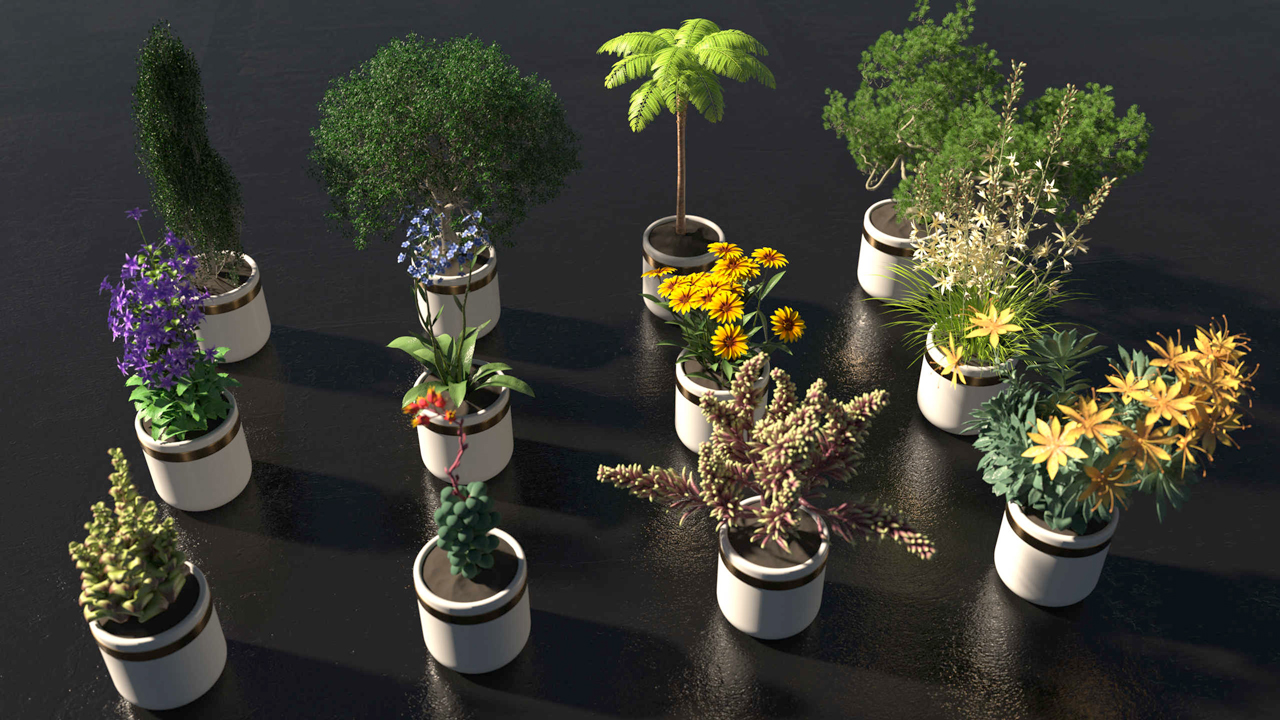 Taiao Preset Pack
Taiao Preset Pack
Get up and running fast with our Taiao Preset Pack. Build flowers, plants and trees, quickly and easily.
- 10 Succulents
- 20 Flowering plants
- 30 Trees
 Nature Materials Pack
Nature Materials Pack
Inspired by nature, our 120 high-resolution drag-and-drop materials mean you can replicate the beauty of nature in no time.
Created using photogrammetry, each leaf is supplied with a front and a back variation. Both complete leaves and barks have all channels needed for full PBR material setups, color, height, normal, roughness, AO and alpha.
Available in 1K, 2K, and 4K resolution for use in any 3D render engine or compositing application.
- 60 cropped leaves
- 70 complete leaves
- 50 Barks
 HDRIs and PBR Materials
HDRIs and PBR Materials
Great lighting and texturing are the key to creating convincing, photo-realistic scenes, but can be time-consuming. Our range of 3D resources makes it easy to get visually stunning results, fast.
With our ready-to-use HDRIs, you can create the perfect lighting and environment to enhance your artistic vision. Our PBR Materials give your models a real-life look and feel with minimum effort.
As a 3D artist, combining the ease-of-use of X-Particles and the realism of Cycles 4D with our 3D Resource Packs brings your creative ideas to life, quickly and easily.
 360 Skies
360 Skies
Create beautiful skyscapes for your 3D environments, from dusk ’til dawn and sun to storm.
Designed by INSYDIUM, 360 Skies offers 126 rendered, spherical sky HDRI maps, including morning, afternoon, and night skies; sunrises, sunsets, and Godrays.
Available in 3K, 6K, and 12K resolution, as well as animated versions, for use in any 3D render engine or compositing application.
 Material Packs
Material Packs
Cycles 4D and RedShift
Photo-realistic materials built from high-resolution image maps for all your 3D scenes.
Created by INSYDIUM’s design team, these Material packs features 223 Cycles 4D and 214 Redshift tileable PBR shaders, including fabric, leather and skin; metals, plastic and car paint.
Available in 2K and 4K resolution, for use with INSYDIUM’s Cycles 4D and Maxon’s Redshift.
 Architecture Packs
Architecture Packs
Cycles 4D and RedShift
Build accurate, realistic architectural scenes with our Architecture Pack.
Produced by INSYDIUM’s design team, these packs include 338 Cycles 4D and 326 Redshift tileable PBR materials, created from high-resolution image maps, featuring bricks, concrete and wood; marble, stone and roofs.
Available in 2K and 4K resolution, for use with INSYDIUM’s Cycles 4D and Maxon’s Redshift.
 Cycles 4D Starter Pack
Cycles 4D Starter Pack
Our first shaders pack to help get you started.
Use INSYDIUM’s Cycles 4D Starter Pack materials to create quick and simple 3D scenes, or learn how Cycles 4D nodes fit together by taking them apart.
250 custom-made materials made by Rob Redman at Pariah Studios, including metal, wood, stone, brick, and others, for use with INSYDIUM’s Cycles 4D.
Always Keep Your Software Up to Date
For more information, see the INSYDIUM Fused Maintenance Agreement page.
Description
X-Particles Features
xpFluidFLIP
xpFluidFLIP features a choice of fluid solvers, APIC and FLIP.
The APIC solver is fantastic at maintaining liquid momentum, preserving the natural flow that your fluids should have and can also provide a more dynamic yet very stable simulation.
xpFluidFLIP has a new collisions system which handles not only static collider objects but also fast-moving or rotating collider objects. It can interact with all other xpDynamics objects giving you endless possibilities.
xpFluidFLIP helps you create detailed, fast fluid simulations, giving you more artistic control than ever before.
xpScatter
xpScatter enables you to scatter your objects over multiple scene geometry, from splines to parametric objects all at the same time.
The topology tab will enable you to distribute your scatter on landscape slope, height, and curvature to create realistic ecosystems.
Animate your growth by using textures, X-Particles modifiers, and Mograph effectors.
Use multiple display modes for fast viewport performance. You can even restrict the scatter of objects to within the camera field of vision for optimal efficiency.
xpCache
Our time and custom spline retiming option give you fine control over playback. The new cache layers in xpCache enables you to lock and unlock to re-cache objects in your scene.
Seamless Integration
X-Particles is built seamlessly into Cinema 4D like it is part of the application. It’s compatible with the existing particle modifiers, object deformers, Mograph effectors, Hair module, native Thinking Particles, and works with the dynamics system in R14 and later.
If you know how to use the Mograph module, you already know how to use X-Particles, it’s that easy.
- Intuitive Workflow
- Data Import and Export
- Field Support
- OpenVDB Export
- Mograph Support
- Particle Caching
Advanced Rendering
X-Particles has the most advanced particle rendering solution on the market. It enables you to render particles, splines, smoke and fire, all within the Cinema 4D renderer. Included are a range of shaders for sprites, particle wet maps and skinning colors. You can even use sound to texture your objects.
Perfectly partnered with INSYDIUM’s Cycles 4D and also compatible with the following:
- Cinema 4D Standard Renderer
- Cinema 4D Physical Renderer
- Arnold, Octane, Redshift
Particle FX
Create outstanding ParticleFX from Solar Systems, FUI, Holograms and medical visualizations to abstract artwork. Multiple options to combine Emitters and Modifiers, gives you a vast range of possibilities.
Data Mapping
Fully exchange, manipulate and combine particle data from every place within X-Particles. Use the Data Mapping tab in each X-Particles modifier to access particle attributes like texture, brightness, speed or temperature, giving a totally new level of control.
Key Features
The three essential driving forces behind X-Particles simulations; Dynamics – bringing life to your particles, Generators – creating geometry, splines, and volumes, and Modifiers – to control and manipulate your particles behavior.
Dynamics
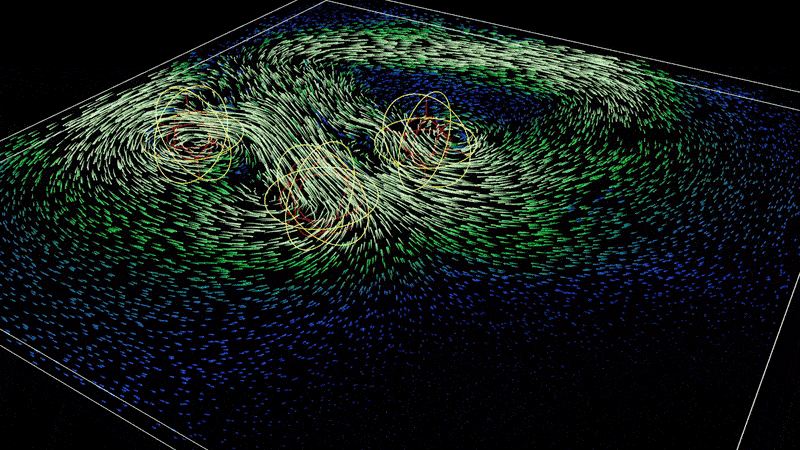
A wide range of Dynamic modules from Constraints to Fluids and Fire means you can add life to your particles, replicating realistic physical particle behavior. Our interactive tools are intuitive, combining a whole host of X-Particles effects using multi-threaded options leaving you with unlimited possibilities and the ability to create caches for the production pipeline.
Generators
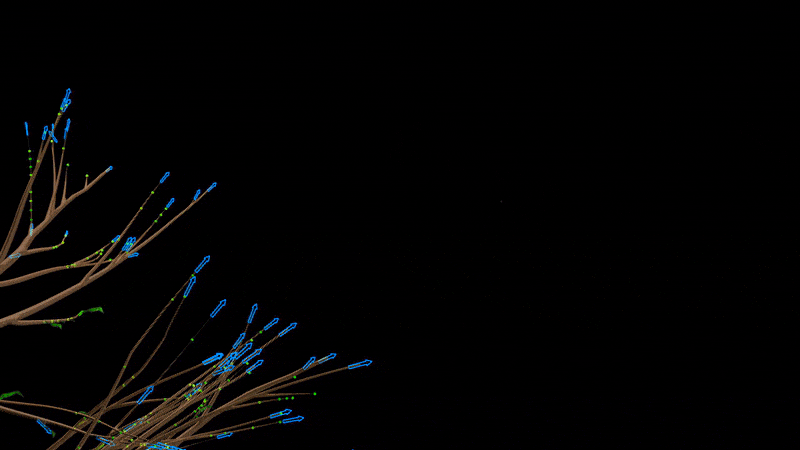
Generate fast and stable geometry and Splines from particles. Attach your animated models to create realistic cache ready simulations. X-Particles comes with Particle Color support, plus the New OpenVDB Support for industry standard meshing.
Modifiers
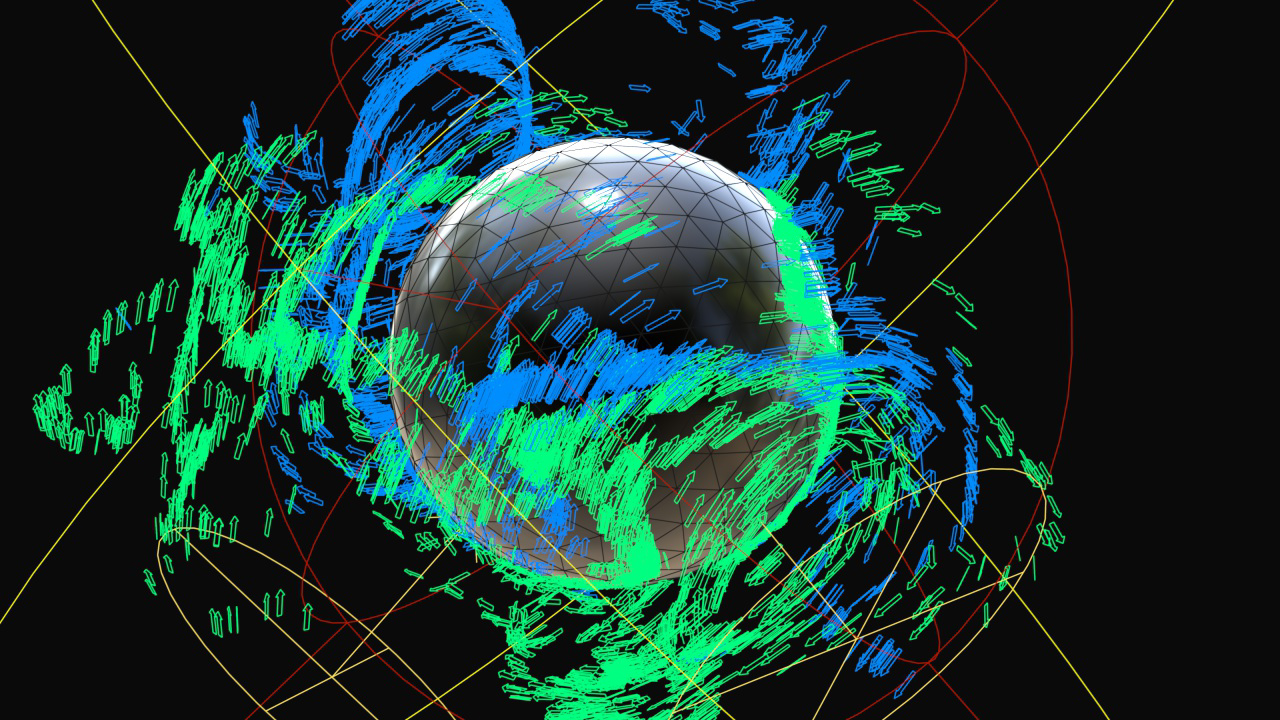
A wide range of modifiers enables you to create exceptional effects, with a simple and intuitive workflow aided by effect stacking. Multi-threaded options and a unique and straightforward system of Questions and Actions means you have full control of your particles. Plus, Data mapping from particle information and complete R20 Field Support.
OpenVDB Meshing
Streamlined workflow for meshing using our filtering system, means you can layer up your effects, generate smooth flowing surfaces, remesh geometry objects or create complex models. OpenVDB enables you to entirely art direct meshes; you can take total control of your artwork.
Smoke, Fire, and Advection
Realistic smoke, fire, and explosive simulations. You can export ExplosiaFX as a VDB volume, and any render engine that can read the VDB data can then render the volume data.
Particle Advection
Add realistic fluid dynamics to your particles, you can also transfer physical and color data from explosions. Advection enables you to combine ExplosiaFX with FluidFX and ClothFX, giving you amazing results.
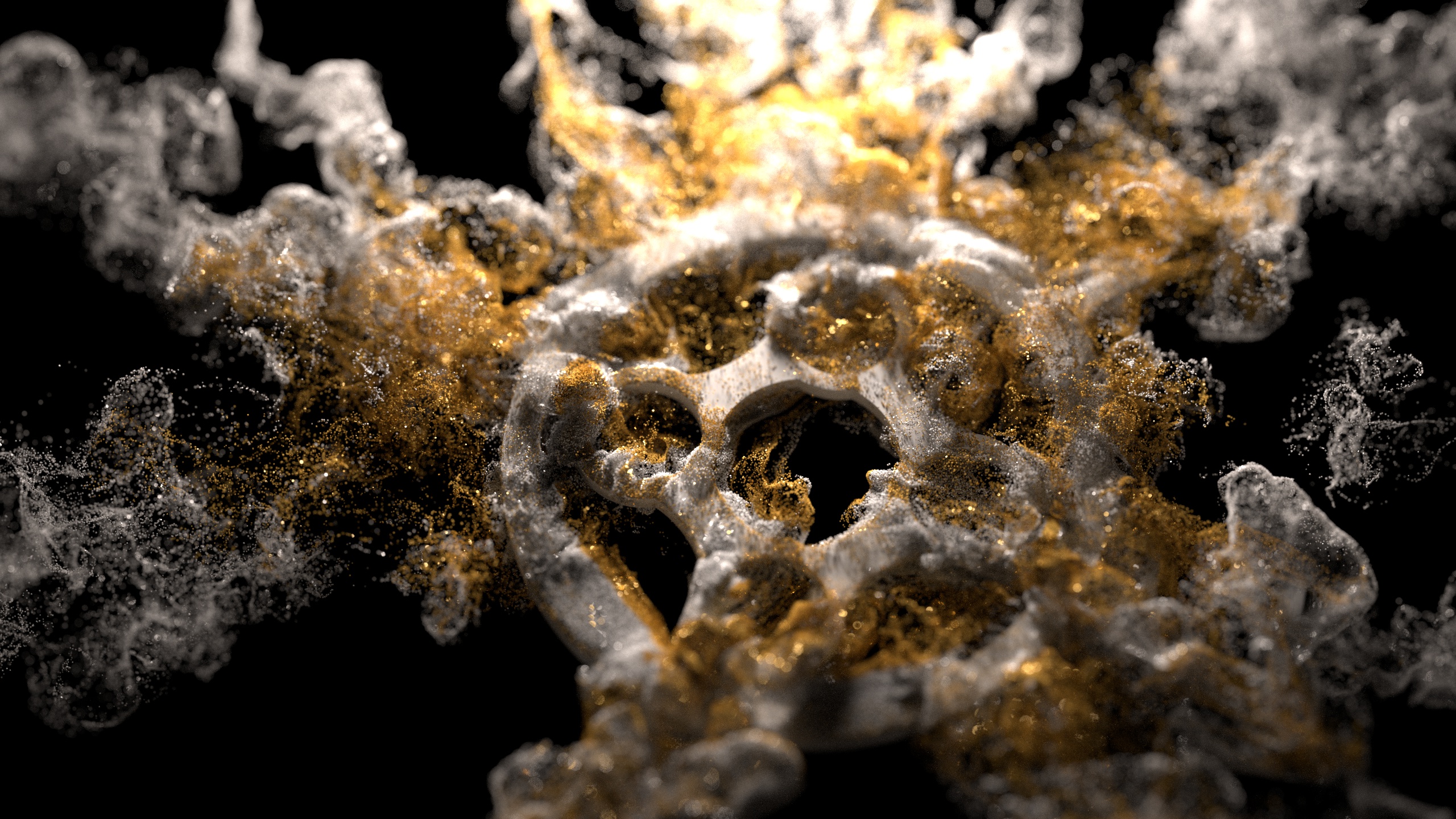
Key Features
X-Particles beauty is its versatility, not only can you create realistic Fire and Smoke simulations. You can also mix ExplosiaFX, Fluid, and Cloth to develop fantastic Advection effects.
Fire
Produce custom chemical burning models to create hyper-realistic Fire simulations. Combine Linear, advanced and smart advection modes, with Pressure, Curl and Turbulence support to create a multitude of combustion effects. Intuitive and Fast workflow means Explosia is the go to tool for all your burning requirements.
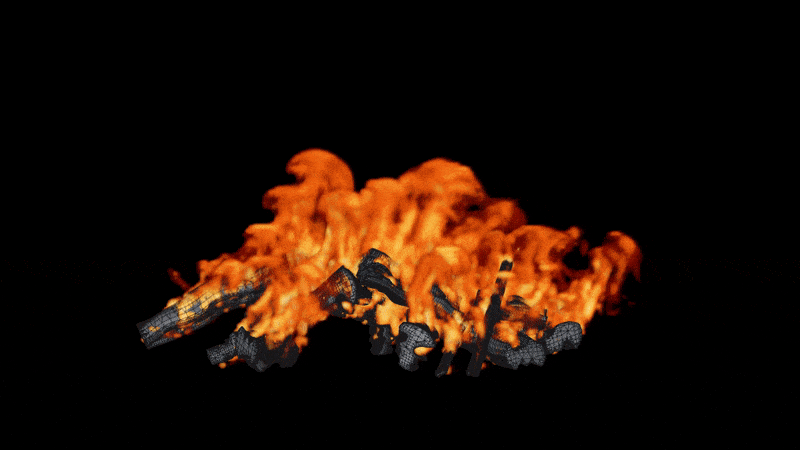
Smoke
Create Smoke effects with Explosia, manipulate the level of diffusion, dissipation, and buoyancy with intuitive precise controls. For the finer details use our Vorticity Refinement, you can also add object collisions to your simulations with fluids or solids. Combined with a range of X-Particle Modifiers, you can generate a truly extensive range of smoke effects.
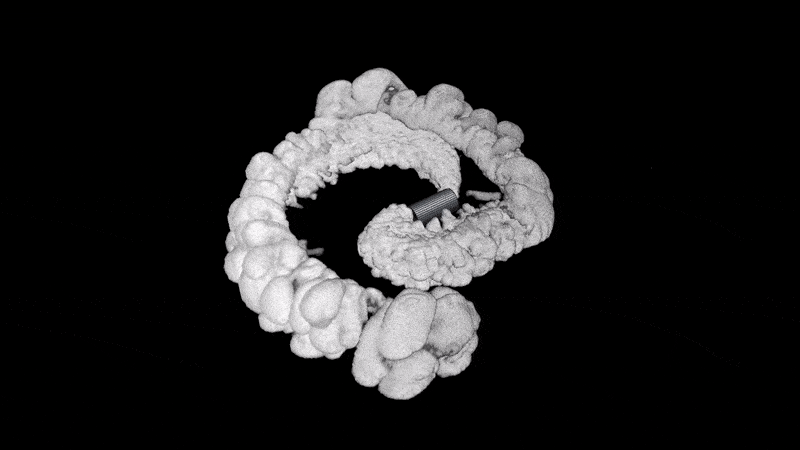
Advection
Advection means you can add hyper-realistic fluid dynamics to your particles. You can transfer physical and color data from explosions. Advection allows you to combine ExplosiaFX with Fluid and Cloths with impressive results.
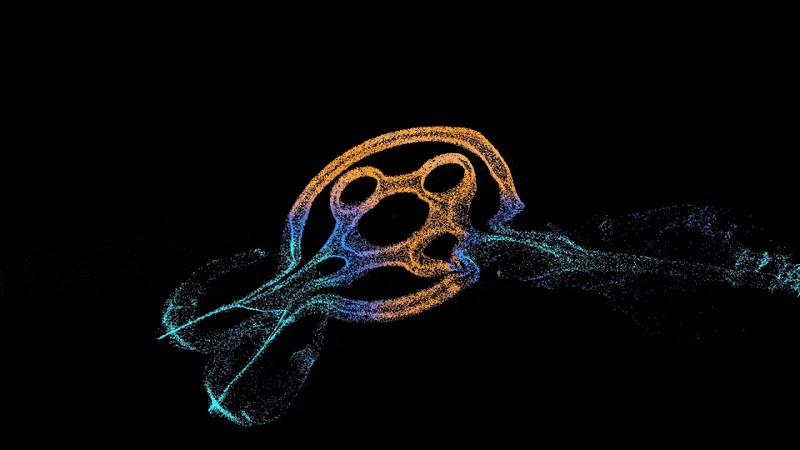
System Requirements
Fused System Requirements
- X-Particles, Taiao, MeshTools and Cycles 4D require Cinema 4D R19* or later.
- TerraformFX requires Cinema 4D R20 or later.
- Your computer will need a processor that has AVX (Advanced Vector Extensions).
- Cycles 4D does not support Apple M Series. For more information, please go to our Knowledge Base.
* The xpExplosiaFX OpenGL viewport display in X-Particles requires OpenGL and a supported GPU with up-to-date drivers. Due to Maxon removing OpenGL from Cinema 4D this feature is not supported in S22 and above.
Operating System
- Windows 7 or later, or macOS High Sierra (10.13) or later.
- The email address used when purchasing Fused will become your registered license email address. This same email address will need to be entered, when requested, in order to use INSYDIUM Fused.
- Plugin licensing is done online so you need an internet connection and must connect at least every 14 days (you can only be offline for 14 days).
- On some Windows systems, you may get a warning that you are missing some runtime files. If so, go to our Knowledge Base where you can download them.
- Some macOS Catalina (10.15) users may experience security warnings when installing. If so, go to our Knowledge Base for instructions on how to proceed.
Cycles 4D GPU Compatibility
nVidia
Cycles 4D is compatible with all PC systems using an nVidia Graphics Card and will render using the GPU.
Macs are CPU only.
AMD
Previous versions of Cycles 4D used OpenCL to render using the GPU on AMD cards (and OpenCL support was also available for nVidia cards).
Due to a lack of support from Apple, Blender have withdrawn OpenCL compatibility on MacOS, meaning that GPU rendering is not available using AMD cards on these systems.
If you are using OpenCL on a PC with an AMD card, this should work, however, cannot be guaranteed and we would recommend installing a Cycles 4D Free Trial license so that tests can be completed.
Hardware
Processor with AVX (Advanced Vector Extensions) required.
A 64-bit machine is required. There are no lower memory limits, but larger amounts of memory will allow larger numbers of particles to be generated.
Internet access
X-Particles must validate your license after installation and once within every 21 days after that. Therefore to use it your machine MUST have access to the internet before you use it for the first time and sufficiently often after that to enable repeat validation. It does not require constant net access all the time.
Needless to say, internet access is required for the online updater to work, but you don’t have to use the updater if you don’t want to.
Other Cinema 4D modules
Dynamics
For use with C4D’s Dynamics, a version of Cinema 4D containing the Dynamics system is required.
Thinking Particles and/or Hair
Thinking Particles is NOT required to use X-Particles. The only advantage of having Thinking Particles is that you can use the X-Particles emitter to generate Thinking Particles, which you could then render with Pyrocluster or the Hair renderer.
However, the X-Particles material provides a better solution to render particles instead of Hair, and its volumetric rendering is superior to Pyrocluster. Therefore if you don’t have these modules, there is no loss of functionality within X-Particles.
Reviews & Comments
Customer Reviews
Phenomenal product
I am just starting to get into using X-Particles Pro but am finding it to be a fantastic plug-in. It's a blast to experiment with and the possibilities are endless. Highly recommended.
Would you recommend this product to a colleague? Yes
By: James Scott
Date: July 17, 2014
Change Log
What’s new in Fused 2023.3.1
- Added compatibility with Cinema 4D 2024
- The INSYDIUM Fused Service Update includes bug fixes to increase performance and stability.
What’s new in Fused 2023.3
X-Particles (Build 1557)
Updated
- List UI – Height scaling option added.
- Local Rotation – Option added to rotations.
- Multi-instance support – Added for xpGenerator and xpScatter.
- xpSplineMesher – Flat mode, new meshing option for Trails.
Caching
- New Spawn and Foam from cached particles, cache support for xpVertexmap.
NeXus (Build 190)
New
- nxAvoid – Changes particle direction to avoid other objects in the scene. It can also be used to freeze and kill particles, once an object is detected.
- nxFlock – Mimics the behaviors and reactions of creatures within a flock, with particles interacting with each other and reacting to stimuli.
- nxInfectio – Simulates growth patterns. It is modeled on the idea of an infection spreading from one particle to another, but you can use it for any kind of growth.
- nxQuestion – Completely redesigned with advanced coding logic integrated into an object-based hierarchy system.
- nxUpres – Interpolates the properties of source particles to destination particles. By using a low-particle count source, and a high count destination, this creates a form of ‘upscaling’ or ‘upresing’.
- nxWave – Generates a velocity field which can create rolling waves within your fluid simulations.
- Data Mapping – Create custom data maps to control various parts of any NeXus modifier, including constraints and fluids.
Updated
- nxBlend – New blend modes and new emitter weighting.
- nxConstraints – Updated node tree GUI for connections and icons for falloff types.
- nxWind – New mode von Kármán.
Taiao (Build 278)
- Significant overhaul improving speed.
- toFlower – Fully procedural layer-based flower system.
- toLeaf – New procedural Leaf generator.
- Modifier stack – Adds modifier layers with fields support to control the plant parts.
- New procedural selections added into each layer.
New Modifiers
- Aim – Use custom objects or upvectors to aim any part of the plant.
- Displace – Use shaders or textures to displace the mesh of Trunk, Branch, Leaf and Petal layers.
- Forces – Updated forces, layer based per part options, new layer weight spline. Forces now supports deforming leaves new options “Curl”.
- Growth – Updated growth system, now fully layer based per part with fields support. New growth animation options for keyframed data.
- Profile – Use a custom spline to set the profile of Trunk and Branch layers.
- Texture – New distribution method, use textures and shaders to distribute Branches and Leaves.
TerraformFX (Build 198)
New
- tfFold Handle support – Viewport handle to comfortably manipulate the fold levels, with simple visualization to indicate the fold direction.
- tfFormula – Use formulas for the generation of abstract animated landscapes.
- tfLightRig – New light rig built into tfTerrain object.
- tfRiver – Create procedural river systems with splines or fully procedural Perlin worms.
- tfTrace – New operator that uses ray tracing to incorporate scene geometry into the TerraformFX height field.
- Distribution Curve – Create custom clone distribution along the road spline in tfRoad.
- GradientUV Shader – Map colors to the terrain surface, based on any data from any operator.
- Preset terrains – Mountain, Valley, Island, Canyon and River.
- Randomize Terrain – New command to randomize and store the settings.
- Road Material – Create center line material in tfRoad.
- Subdivide Bottom – Option within tfTerrain, construct the bottom face using a subdivided plane.
MeshTools (Build 243)
New
- mtRayline – Procedural ray casting spline generator.
- mtSplineFX – Spline effects generator tool.
Updated
- All spline generators now have built-in gradient displays.
April 2023
This latest Service Update (Build 1493) is available now via the online updater. This update includes fixes for X-Particles and NeXus.
September 2022
INSYDIUM Fused consists of
X-Particles (Build 1480)
Maintenance Plugin Benefits
- NeXus (Build 60)
- Taiao (Build 141)
- TerraformFX (Build 164)
- MeshTools (Build 190)
- Cycles 4D (Build 559)
Updates
Maintenance Benefits
NeXus
NeXus is a GPU particle and simulation system that integrates perfectly into the X-Particles ecosystem.
Bringing many standard modifiers into the NeXus GPU framework means faster fluids and standard particle effects.
- nxConstraints
- nxFluids
- nxFoam
- nxAttractor
- nxBlend
- nxDirection
- nxDrag
- nxExplode
- nxGravity
- nxKill
- nxRotate
- nxPush
- nxScale
- nxSpeed
- nxTurbulence
- nxVorticity
- nxWind
Taiao
- New Growth System– We now have individual control over branches, which can be added dynamically. Leaves, Flowers and Custom Objects have individual control with variation and support for Fields, using the Growth tab.
TerraformFX
New Feature
- tfWarp – Distorts the input height field, using a low-res control grid of 2D displacement vectors.
- tfFlood – Flood valleys, or clip off mountain tops, with ease and mask the results with the tfFlood operator’s custom output map.
- Grid Monitor – Constantly monitor your operators’ 2D outputs with the new Grid Monitor dialog, that can be freely docked into your layout.
- Shader Masking – Use textures and shaders to quickly mask your operators without having to use Fields.
Update
- tfGrid – Control output map
- tfSpline – New fill mode
- tfBrush – New modes for warp and grid
- tfBlur – New median filter
MeshTools
New Feature
- mtFractal – Procedural fractal tool
Update
- mtEdgeSpline – New offset with count and rotation
Library Assets
New
- Taiao Preset Pack – Get up and running fast with our Taiao Preset Pack. Build flowers, plants and trees, quickly and easily.
- Nature Material Pack – Inspired by nature, our 120 high-resolution drag-and-drop materials mean you can replicate the beauty of nature in no time.
Fused March 2022
INSYDIUM Fused consists of
- X-Particles (Build 1250)
Fused Plugin Benefits
- Taiao (Build 80)
- TerraformFX (Build 147)
- MeshTools (Build 131)
- Cycles 4D (Build 557)
Updates
Taiao
A procedural plant animation system which generates trees, flowers, grasses and custom objects.
toPlant Procedural layered based modeling plant generator. Use layers to add branches, leaves, flowers and custom objects to build any type of plant or tree.
toTree Simulation-based system creates natural growth based on rules. Use space colonization to build branching systems based on points in a volume or particles.
toGrass Grass generator, add grass and scatter plants and objects over the surface of any object.
TerraformFX
New Features
- Generators
- tfGrid Adds a grid of adjustment handles; with these, you can custom design the landscape, including a new grid brush to paint and sculpt the land.
- Filters
- tfPath Procedural path operator, add a custom spline to generate paths and roads in the landscape.
- tfErosion Snow New Erosion operator, tfErosion Snow lets you add snowy materials to your terrains.
- tfHighpass Filter to help maintain details in existing layers without destroying the original form of the landscape.
- Others
- tfRoad Part of tfPath, the new tfRoad generates a procedural road based on the path, with built-in cloning for adding roadside structures.
MeshTools
New Features
- mtSplineSample lets you resample the input spline to add uniform, adaptive and distance point distribution modes.
- mtPolyScale Takes an input geometry and scales down the faces.
- mtRemesh Remeshes the input geometry into a Delaunay triangulation-based mesh surface.
Updates
- mtInset
- Divisions feature adds more divisions along the length of the inset.
- Divisions deform spline lets you deform the shape of the offset with the spline.
- Twist twists the inset face.
Fused Hotfix Update – 28 September 2021
This Update contains bug fixes for Licensing, xpDynamics, xpShatter, xpCache, and TerraformFX, all of which will increase performance and stability. In addition, users will find that the following xpCache fixes make the cache ‘dialog’ far more responsive.
X-Particles Build 1036 and TerraformFX Build 122
- 4254 – xpDynamics – xpGenerator failed to cache
- 4248- xpDynamics – xpShatter failed to initialize reliably
- 4241 – xpShatter – Any offset from global zero breaks recursive shard positions
- 4244- xpShatter – Hang on Collision Trigger mode
- 4243 -xpCache – Dragging the progress dialog affects cache speed (R25)
- 4242 – xpCache – Mouse movement halts cache progress (R25)
- 4240 – TerraformFX – Operator changes fail to update the terrain without forcing a redraw
- 4238 – Change License – Re-enabling a license causes application hang (R25)
If you are an eligible customer, you will receive this Hotfix Update automatically, as long as you have enabled your Online Updater. Alternatively, you can access the latest build of Fused for your license from your Customer Account.
X-Particles Build 895
9 September 2020
- 3284 – xpOVDBMesher: Crashes Cinema 4D R23 when Transfer Point Color enabled
- 3283 – xpFlowField: Layer strength can’t be keyframed
- 3270 – Adding any X-Particles Falloffs will cause Cinema 4D to Freeze
- 3269 – xpExplosiaFX: Display issue when moving between scenes
- 3265 – Adjusting the xpMorph Threshold Slider does not do anything
- 3262 – Changing the “emitter shape” to “object” then drag in any object such as a sphere or cube crashes Cinema 4D
- 3260 – xpLight mod brightness setting not correct
- 3259 – Gradient color is not an available option in a Sub Branch Object
- 3257 – X-Particles is crashing when using xpCellAuto with xpTrail
- 3255 – Particles passing through object using xpAvoid
- 3250 – xpColor: The intended color is not displayed using both color operation settings
- 3249 – X-Particles System Preferences: Enabling System HUD crashed Cinema 4D R23
- 3248 – xpColor: Fade between is not finishing on the desired color
- 3245 – xpExplosiaFX: Color Display not working when using a Cinema 4D deformer
- 3240 – xpScatter: The scattered objects are not updating correctly when used with xpVertexMap
- 3238 – xpScatter: Does not get sorted when using SystemSort
- 3237 – xpExplosiaFX: Cached VDB file performing poorly
- 3218 – xpExplosiaFX: Crashes C4D if OpenGL is turned off in preferences
- 3217 – xpVertexMap: Color Vertex Map options – only displays particle layer weight, and not the full layer set
- 3214 – xpBranch: Not able to set the angle mode of the branching when using Curl mode on the source branch
- 3209 – xpFlowField: Does not reset as expected
- 3205 – Particle Emission from Extrude Caps issue
- 3204 – xpScatter: Viewport Display affects Render
- 3200 – xpBranch Curl vs Animated Plane Angle
- 3184 – xpAvoid: Currently has no import
- 3181 – xpExplosiaFX OpenGL vs Backface Culling
- 3174 – xpVertexMap: The field is using the wrong matrix
- 3172 – xpVertexMap: Animation of the seed object stops when the invert checkbox is selected
- 3138 – X-Particles crashes Cinema 4D during the upgrade on Mac 10.10 Yosemite
- 3132 – xpExplosiaFX: If SubSteps is above 1, particle gaps occur
X-Particles Build 884
Friday 3rd July 2020
In this Update, we have focused on our core foundations, rebuilding, refining, and enhancing. X-Particles is an essential component of an artist’s toolkit, and as such, we are continually improving our workflow so our customers can work more efficiently. We’ve so many great things to show you.
Please note: X-Particles Build 884 is the last Update that will support Cinema 4D R14 to R18. Future Updates will support only R19 and later and your computer will need a processor that has AVX (Advanced Vector Extensions).
This Update contains all the features previously available in the Beta Access build, plus some additional new and updated features.
New Features
- xpFlock
- xpOcean
- xpScatter
- xpSticky
- xpBlend
- xpNegate
- xpPushApart
- New icons
- New Scheme colors
- Token Support
- xpJoin
- Trail Display added to xpFlowField, xpExplosiaFX and xpFluidFLIP
Updates to Existing Features
xpSystem Object
- New layout
- Renamed Other objects to Utilities
xpEmitter
- New Emission mode Simulate
- New Emission mode Motion
- Threshold (Vertex Map)
- New Origin Display
- Texture UV Switch
- Rotation Display mode
- Unified Questions list, icons for each mode
- Unified Modifier list, icons for include/exclude
- Added New Offset Channel to Texture emission
- New rotation ‘Face Screen’ mode
- New Physical Data User Value
- New Shot modes for Regular and Hexagon emissions
xpVertexmap
- Completely rewritten, new UI/UX
- New From VertexMap mode
- New Curvature mode
- New Ambient Occlusion mode
- Support for parametric objects
- New Effects options
xpFlowField
- Completely rewritten, new UI/UX
- New Speed Mapping in data mapping
- New Turbulence mode
- New Curl mode
- New ExplosiaFX mode
- New Surface mode
- New Fields mode
- New Import Flow
- Updated Export settings
- New Trail Display mode
- New shader mode gradient option (removed old RGB)
Questions
- Question New Direction Change Question
- Question New User Value, linked with Emitter User Value options
- Question Sub Question now Changed to a Standard Question
xpDisplay Render
- New Collider Bounds mode
- New FlowField Trails mode
- New xpExplosiaFX Velocities mode
- New xpFluidFLIP Velocities mode
xpBranch
- New Curl mode
- New Control splines for Curl options
- New Symmetrical option
- New Intersection system
xpDynamics Modifier – New Auto Fade
xpMultiSpawn – New Start at Age and Offset
xpExplode – New Trigger modes
xpLimit Modifier and xpMetaGroup – New user value
xpNetwork and xpAvoid – New Intersection system
xpTurbulence – Updated Defaults
xpSplineMesher
- New Growth Slider
- New Vertex Colors
Actions
- New Output to Console Action added
- Change Group Action support for physical Data
- New Rotation mode added to Direct Spin Action
xpCache
- New Unique IDs
- New List View of Cached Items
- New Retiming options
xpDomain
- Renamed xpFluidFLIP
- New APIC solver
- Rewritten collision system
- New Solid Object options
- New Sticky functions
- New CFL Options
- New Resampling feature
- Removed legacy smoke and fire
- Optimized core
- New Trail Display for velocity
- New Allow Inflow
- New Liquid Surface
xpExplosiaFX
- New Upres options
- Updated container size options
- Adaptive bounds color added to Display options
- New Solver information readout added
- Gravity set to match XP
- New Motion Gap added to solve stepping in simulations
- New Velocity added to Geometry tag
- Rewritten Custom section
- New defaults
- Removed simple
- New OpenGL display added (currently works in Cinema 4D R14 to R21)
- New Trails Display mode
- New CFL option added
- New Substep options added
- Rewritten collisions
- New Vorticity and Turbulence options
X-Particles Service Update Build 742
Released 22 January 2020
This Service Update contains bug fixes which will increase performance and stability. This is available to all X-Particles customers in their Maintenance Period.
X-Particles owners will receive this update automatically, as long as you have enabled your X-Particles Online Updater. Alternatively, you can access the latest build of X-Particles for your license from your Customer Account.
Remember, with the addition of Customer Accounts you will be able to track your maintenance expiry and access your downloads. You’ll also be able to view your previous order history, download and print invoices, and if you are in your Maintenance Period access exclusive Maintenance Training videos and Content Repository files.
If you haven’t set up a Customer Account, register now.
Microsoft Windows users may need to install the latest Microsoft Visual C++ Redistributable 2015-2019, see our Knowledge Base for more details.
Bug Fixes
2693 – xpOVDB Mesher Zero Data in Velocity Maps
2683 – xpOVDB Mesher incorrect Trails Velocities
2691 – xpOVDB Mesher won’t render when cached
2686 – Cached Cloth crashing Cinema 4D
2685 – Modifier field question error
2682 – Collider Tag doesn’t work on Motext
2681 – Emitter is being generated outside xpSystem
2677 – Cloth xpCollider crash
2669 – xpFlowField vs Emitters Activation
2668 – xpFollowPath Modifier crash
2663 – xpCollider crashes randomly
2661 – Cloth Constraint not set up
2660 – xpSound Crash/Freeze while adding sound file
2654 – Collision tag – spawn
2650 – R21 crashes when XPCache finished caching
2649 – xpSound crashes when frequency max is reduced
2644 – Load XP palette failure
2639 – Collider not working with xpFluidFX
2638 – xpDynamics incorrect File Structure
2628 – xpColor Falloff Failing to return Color
2626 – xpSprite misnaming on CSTO
2625 – Cache info missing in R21
2623 – Leaking Colliders
2620 – Fluids xpFoam crash
2615 – XP crash of cache completion
2613 – Crash while rendering to picture Viewer in R20-R21
2607 – xpScale Falloff Substeps issue
2606 – Shatter Bad Normals with Scaled Objects
2605 – Data Mapping doesn’t work in the attractor modifier
2592 – Fast moving object used as xpCollider and xpFlock avoider, crashes Cinema 4D
2589 – xpPPCollisions crash
2580 – xpGenerator + xpCollider crash
2579 – Old scenes which use xpOVDB Mesher are crashing when opening
2555 – xpOVDB Mesher Redraw
2505 – xpShatter layers copy/paste issue
2504 – Point Container undo
2493 – Shatter Emitter undo issue
2356 – No Generation of XP generated objects
2238 – Pulse emission has random results
2219 – Connect on collision affects spawning from an unrelated emitter
Build 732
- Adds Cinema 4D R21 Compatibility
Cinema 4D API Changes
Cinema 4D R21 has seen API Changes. As a result of these changes, all third-party developers such as INSYDIUM, have had to adapt their plug-ins. X-Particles is a sophisticated piece of software, which means these changes take up significant development time and it is only possible to implement them on our latest builds.
X-Particles C4D compatibility explained:
- X-Particles 3.5 Cinema 4D R14-R19
- X-Particles 4 (Build 535) Cinema 4D R14-R20
- X-Particles Build 642 Cinema 4D R14-R20
- X-Particles Build 728 Cinema 4D R14-R20
- X-Particles Build 732 Cinema 4D R14-R21
X-Particles Public Release 2019
Build 724 – Thursday 4th July 2019
New Feature list
This version contains all the features previously available in the Early Access builds to May 2019, plus some additional New and Updated Features.
New Features
- xpDynamics – New Dynamics solver for Rigid and Soft Body Dynamics.
- xpShatter – New Voronoi based shattering system.
- xpDisplayRender – New Render generator to render Particle and Display Modes.
- xpMetaGroup – New Powerful type of particle group.
- xpQuickTools – New integrated preset tools.
- xpSplineGrowth – New Deformer to grow spline objects, Trails and Elektrix.
- xpTrailTip Tag – New Tag to add an object to tip of trail splines.
- xpParticleSampleShader – New Shader to colour objects from particle parameters.
- xpSheeter – New Modifier to generate thin film particles in Fluid simulations.
- xpSplash – New Modifier for crown splash simulations.
Updates to Existing Features
- Emission from Object – Rotation mode Tangential to Normal.
- Colour Modifier – Colour from vertex tag, change particle shape.
- Inherit Modifier – More options to inherit and control when inherited.
- Spawn Modifier – Inherit UV emission data from source.
- xpVertexMap – Vertex colour from particles.
- Drag Modifier – Use Scene units and new Shatter mode.
- Scale Modifier – New Percentage option for scale, and shader mapping.
- Infectio Modifier – More color control with groups.
- Physical Modifier – Use Shaders to control options.
- Cover Modifier – Two new modes ‘Nearest Surface Point’ and ‘Nearest Vertex’ added for more control over material channels.
- Attractor Modifier – New Viewport icon to show where particles will be attracted to.
- Vortex Modifier – New Helix mode.
- Custom Data – New variation field.
- xpTrail – New object mode.
- Network Modifier – New distance mode.
- Emitter Display – New cylinder mode.
- Emitter Direction – New option persists while stuck, enables particles to maintain correct axis direction on deformed normal.
What’s new in X-Particles 2018
New Feature list in Build 642 – Wed 24th Oct 2018.
This version contains all the features previously available in the Early Access builds to September 2018, plus some additional New Features.
General
- Revised particle core and collision engine with much greater speed
- Compatibility with Cinema 4D R20 using the INSYDIUM Bridge plugin
- R20 Fields are now supported, the Falloff tab of any object now shows the standard Fields display. The X-Particles falloffs are in the Fields list in their own panel (this applies to Cinema 4D R20 only)
- Enhanced quick tab functionality in the user interface
Emitter
- New emitter type – Torus emitter
- Emitter instance mode added
- It is now possible to set the colour for different constraint types and render trails from the constraints using those colours
- New extended data item – Emission Vertex
- Changed particle colour by shader to give correct 3D sampling
- Revised particle colour gradients in the emitter/group object
- New modifier fields display
- New variation control added to emission along object normals
- Edge-only emission for the emitter in rectangle mode
- New up-vector option in the emitter rotations
- New option added to the emitter falloff
Generators
- Enhanced functionality and the ability to mesh volumes in the OpenVDB mesher
- New option in the Trail object to handle Infectio trails
- Option to create a Vertex Color Tag added to the Fragmenter object (Cinema 4D R18 and higher only)
- New distance controls in xpElektrix
Dynamics Objects
- Faster, more accurate fluid simulation in FluidPBD and FluidFX
- FluidFX has been greatly improved and is much faster
- New Wave object added
- Improvements to the Foam object to give more control over the foam offset from the fluid surface
- Particle group and falloff support added to ExplosiaFX
- Revised and enhanced Shader mode in the FlowField object
Modifiers
New Infectio modifier
More inherited parameters added to the Change Group and Spawn modifiers
New list of target objects added to the Attractor modifier
Mograph Cloner/Matrix support added to the Attractor modifier
New force and velocity settings added to the Attractor, Cover/Target, Flock, Rotator and Vortex modifiers
Improved and extended Color modifier
Custom data can now be mapped to particle data in the Custom Data modifier
New threshold setting in the Geometry modifier
New options added to the Kill modifier
New mode and new switch added to the Life modifier
Revised and extended Limit modifier
New axis constraint setting in the Network modifier
Three new attractors added to the Strange Attractors modifier
New functionality – actions on trail zero length – added to the Trails modifier
New mode of operation in the Weight modifier
Other Objects
- New X-Particles Seed Object used in the Infectio modifier and in the VertexMap Maker
- New mode in the VertexMap Maker – ‘From Seed’
- Ability to add a Vertex Color Tag in the VertexMap Maker (Cinema 4D R18 and higher only)
- Z-axis formula and displacement shader added to the Trail Deformer
Questions/Actions
- Can now disable/enable individual questions and actions in the emitter Questions tab and in Actions lists in all objects
- New Fluid Data questions in the Question object
- Self-spawning feature added to the Control Spawning action
- New action to control the Infectio modifier added
Other
- New System Hierarchy Sorter command to sort X-Particles objects into a System object
- New option in the X-Particles preferences: automatically add newly-created X-Particles objects into a System object
- New parameters added to the main X-Particles preferences
- With data mapping, you can now map modifier parameters to a vertex map tag
- The Xpresso get/set particle data nodes now allow you to get or set the Infectio state of a particle
- The X-Particles console has been updated and improved
- New features added to the Distance shader
- The Load Palettes facility missing from the original release has now been restored
- Spline collisions added to the collision engine
- Adaptive collisions and their display in the Collider tag
- The FluidFX Collider tag no longer exists and the standard X-Particles Collider tag should be used in its place. See the FluidFX page in the online manual for more details
What’s new in X-Particles 4.0
New objects in X-Particles 4
- New Dynamics Objects
- Cloth FX
- Explosia FX
- Flow Field Object
- Fluid FX
- New Generators
- OpenVDB Mesher
- Planar Mesher
- New Modifiers
- Custom Data Modifier
- History Modifier
- MultiLevel Spawn Modifier
- Sound Displacement Modifier
- SplineFlow Modifier
- Strange Attractor Modifier
- Trails Modifier
- New Tags
- Cloth FX Tag
- Cloth FX Pin Tag
- Explosia FX Collider Tag
- Explosia FX Source Tag
- Fluid FX Object Tag
- Newtonian Gravity Tag
- Other New Objects
- Cellular Automata Object
- Circle Packer Object
- Data Export Object
- Data Import Object
- Distance Shader
- Object Shader
- Shader Falloff
- VertexMap Maker Object
- X-Particles Console
Other features
- Custom data
- Each particle always carries a set of data values (e.g. speed, radius, mass, etc.) but with this feature in X-Particles 4 it is possible to add your own custom data. How this is used is entirely for the user to decide, but examples are given on the custom data page which explains how to add custom data and how it can be used.
- Changes/additions to existing objects
- Actions
- New actions:
- several actions to control new modifiers
- Change Trail action has new ‘Connections’ action
- Custom Data action new mode added to allow incrementing/decrementing the current data value
- Branch Modifier
- Branching algorithm improved and legacy mode added to preserve existing scenes
- Collider Tag
- The ‘Exclusions’ tab now has an Exclude/Include menu so that it can now accept emitters to exclude or include in collisions with the object.
- Colour Modifier
- * New operation modes added
- * Fade Between
- * Distance From Object
- * Distance From Camera
- * Gradient by Parameter modes replicate emitter gradient modes
- Data Mapping
- Can now map to additional data including:
- Particle index
- Distance to target using either a cover mod or an inherit mod
- Spline segment length if using a follow spline modifier
- Particle scale
- Shader support added (i.e. map to a shader such as Noise)
- Support for texture tags added (i.e. can map data to an existing material)
- Direction Modifier
- New relative direction mode added
- Actions
- Emitter
- Object tab
- Emission can be controlled by object colour when emitting from an object
- Improvements to illumination-controlled emission
- Particles can be emitted from ngon centres
- Moselection tag is supported when emitting from a Mograph cloner
- Support for emission from a Mograph Matrix or MoText object
- In defined emission, radial mode now has a ‘reverse’ switch to reverse the initial direction
- Particle radius can now be controlled by texture and by emitting polygon size
- Topology-controlled emission (height, slope, and crevices)
- The Voronoi Fracture object selection tags are now supported
- Emitting from the position of each object in a Mograph Cloner is now supported and a multiplier setting added to increase the particle count
- Emission tab
- New emission modes added for uses with the Advanced Fluids module
- Extended Data tab
- Rate of change control added for particle rotations
- Up-vector added for particle rotations
- Particle mass can now be linked to its radius
- Ability to store UV data to the particle added to the Extended Data tab
- Ability to enter custom particle data added to the Extended Data tab
- Groups tab
- Groups list can now use the conventional ticks/crosses icons to disable or enable groups, and can use groups in hierachies with the hierarchy icon
- Display tab
- Outline Multiplier control added
- Can now set the emitter icon colour
- Modifiers tab
- Modifiers list can now use modifiers in hierarchies rather than having to add modifiers individually
- Follow Path Modifier
- New switch added to reduce the crossing over of particle trails when the particles move to the first path object
- Support for Actions to be executed when the particle enters the path
- Follow Spline Modifier
- Support for Actions to be executed when the particle is captured by the spline
- New speed mode added
- Follow Surface Modifier
- Falloff tab added to modifier
- Object tab
- Gravity Modifier
- New mode added – Newtonian gravity
- Limit Modifier
- Mapping of limits to individual axes is now possible
- Particles Falloff
- Groups can now be used in the falloff
- Question Object
- New questions:
- Particle-Particle Collision question
- Time in Group question
- Custom Data question
- Particle Has Connections question
- Fluid Surface question
- New mode added to the Particle Age question
- New questions:
- Scale Modifier
- New variation setting added
- Spawn Modifier
- Spawned particles can now inherit scale and/or radius from the source particle
- Sprite Object
- Orientation setting added for placard sprites
- Sprite lights can now use lens effects
- New text mode added – ‘Uset Text (Phrases)’
- System Object
- New switches added to the System Object to apply the only modifiers/deformers in the same system to all emitters in that system (no longer necessary to set the switches manually in each emitter)
- Ability to move/rotate a particle stream when the parent System object is moved/rotated
- Ability to change the colour of the System Object icon to any colour, or to use the colour of the scene layer the object belngs to
- Trail Object
- Maximum length setting added to the ‘Straight Sequence’ algorithm
- New ‘Multiple Sequence’ algorithm added
- New thickness mode added – Use Radius (Variable)
- Cached trails can now retain their colour
- Turbulence Modifier
- New Simplex noise (modified Perlin noise) added
- Xpresso nodes
- The Set Physical Data node now allows you to set the particle group directly rather than using a separate node
- New Get/Set Custom Data nodes added
What’s new with service pack 2 for X-Particles 3.5
Changes
- Cycles 4D Ready, sign up to our Newsletter and be the first to find out more.
- Licensing speed improved to reduce starting delays.
- Offline license server support for multiple Cinema 4D licenses.
- xpSkinner Support for Cinema 4D R18 Vertex Color Tag.
Fixes
- 834 – Cache Read Not Ignoring Hidden Files.
- 835 – Cache tag enable state not saved.
- 839 – Wetmap UVs gap.
- 889 – Generator not rotating along with particles during animation.
- 890 – Modifier Source Falloff strange bounding box.
- 891 – xpCache, xpSystem and xpGroup.
- 894 – xpTransform Subframe Problem.
- 902 – Volumetric material missing from Object Buffer.
- 914 – Caching broken in R18.
- 915 – Rewind mod mapping crash.
- 919 – Actions Incorrect Data type.
- 921 – XP Crash.
- 925 – xpSkinner on Thinking Particles.
- 927 – Stick particle to source not working when one particle per source is selected.
- 933 – Crash if using a TP group as the skinner source with second flag set to polys.
- 935 – Stick to stopped working.
- 938 – xpTurbulence Frequency broken.
- 942 – xpCache Playback broken in R18.
- 947 – xpCache Save & Load Scene Broken!
What’s New in Version 3.5
Illumination based emissions. Use Cinema 4D lights to trigger particle emissions from surfaces.
FollowPath meets Cloner. In our latest update, the xpFollowPath Modifier has direct access to the Mograph Cloner object, you can use closed Splines inside a Cloner object, giving you even greater control over particle paths. Control like never before!
Trail Deformer. Our new trail deformer helps you breathe life into your trails, use formulas or shaders to deform your trails and add animation for full control over the trail object.
xpParticlesFalloff. Now you can use particles as single falloff objects. Our exciting new xpParticles Falloff will open the door to endless possibilities, from random growth to unique color changing effects. Let each particle become the controller of your modifiers.
Enhanced Group Object. Giving you more control over your particle groups. The group object can be used in 3 different modes, from display only to control over particle properties.
xpSound Modifier. Use sound to drive your particles parameters, speed, color, size and much more. Audio has never been this compelling.
What’s new in version 3
X-Particles 3 has over 40 particle modifiers with many modifier improvements, such as new flocking, giving even more control over your particle VFX.
18 New Modifiers
- Control
- xpColor, xpInherit, xpPhysical, xpRewind, xpTransform, xpWeight.
- Motion
- xpAvoid, xpDrag, xpExplode, xpFollowPath, xpGaseous, xpLimit, xpNetwork, xpVortex, xpVorticity.
- Generate
- xpBranch, xpDynamicParticles, xpTendril.
All New Core
- Faster with reduced memory1 use enabling simulation of more particles with the same resources2.
- More power to your CPU, increased threading across X-Particles making more use of multiple cores including threaded caching and compression making caching 4 times faster3.
- Subframe Modifier Execution, complete user control over modifiers and dynamics for more accurate simulation and less particle banding artifacts.
1 compared to X-Particles 2.5 with a basic two million particle scene.
2 subject to modifiers used, each modifier can dynamically add data needed during execution.
3 subject to file format used, X-Particles native caching is the fastest and X-Particle 3 enables you to customise what data to save.
Licensing
New serial number system independent of CINEMA 4D : license management and entry directly into X-Particles with no more need for serial number updates with new CINEMA 4D releases or having to add X-Particles to the MAXON license server.
Workflow
Many improvements to the intuitive X-Particles workflow including:
- X-Particles System Object updated with viewport display, quick access to new modifiers from the OM, full system presets.
- Many more Questions and Actions to boost the power of your particle VFX.
- Additional particle control via emission properties for Groups.
- Partio file format support to enable import and export of particle caches to popular particle file formats for quick and easy transfer between applications.
Generation
Particle and mesh generation including:
- xpElektrix for quick and easy lightning vfx.
- xpSplineMesher creates polygons from any CINEMA 4D spline, X-Particles trails and particle branching.
- xpVolumeEmit controls emission of particles from object volumes.
- xpBranch enables creation of organic structures including tree and plant like formations.
- xpTendril creates dynamic flowing tendrils.
- xpNetwork gives organised particle movement to create vast patterns.
Dynamics
- Enhanced dynamics with advanced liquid and gaseous simultion.
- xpDomain brings advanced Liquid and Gaseous (Smoke and Fire) simulation into the standard X-Particles workflow enabling simulations to use the X-Particles modifiers plus Questions and Actions system.
- xpConstraints adds dynamics for viscosity, friction, surface tension, particle connections, fast particle to particle collisions and forces.
Rendering
- The blazingly fast X-Particles render engine has been enhanced to bring in spline rendering, volumetric and voxel rendering.
- The enhanced X-Particles Material enables more control and properties for shading your particles including the ability to drop the material onto a spline and have it render, including shading Trails from the particles.
- X-Particles Material > Volumetric enables rendering particles as smoke, clouds and other volumetric phenomena, including isosurface (Skinner like) renders.
- Volumetric Voxels turn your particles into voxels at render time to turn them into one continuous volume for realistic gaseous rendering.
- X-Particles Gaseous is a new X-Particles material that builds on the X-Particles Material Volumetric Voxels to bring Smoke and Fire rendering.
New Features in 2.5
- Many enhancements to the emitter object.
- Greatly improved, faster and easier fluids.
- Blazingly fast high quality rendering and Multi-Pass.
- Wet Maps.
- Polygon Fragmenter.
- Additional skinner surfaces.
- Particle painting, creation, deletion and properties such as color, speed, rotation and life.
- Extra modifiers and enhancements such as Move over Surface and Falloff over Life.
- Completely new, flexible and powerful caching system.
Emitter
- The emitter object includes a host of new features:
- Motion inheritance.
- Initial emission state.
- Defined emission.
- Many new options for emission from objects.
- Additional support for mograph effectors.
- Particle rotations.
Fluids
- Fluids in X-Particles 2.5 have had a massive overhaul:
- Faster and easier to control with additional options to enhance the results of your fluid simulations.
- Enhancements to viscosity and vorticity.
- Boundary density correction and surface repulsion and attraction.
- Diffuse particles such as spray and foam.
- Wet maps created from particle to surface interactions.
Rendering
- Major rendering enhancements bringing substantially faster and higher quality particle rendering.
- X-Particle material additions such as Fill Particles and additional illumination models.
- Light tag for finer control of lighting and shadows.
- Multi-Pass layers including depth, vector motion blur, object buffers and position/normal passes.
Fragmenter
The exciting new Fragmenter object in X-Particles 2.5 enables you to turn the faces of any polygon object into your own controllable particles.
You can use it to drive a single object or a hierarchy of objects as particles, giving you the freedom to take your animations to another level.
Particle Paint
Open the door to your imagination with our powerful new painting tools. Particle paint lets you paint particles directly into your scene onto any object’s surface, right within the CINEMA 4D viewport. The possibilities in this tool truly let you unlock your creativity.
Wet Maps
New in X-Particles 2.5 is the superb new Wet Map Tag. This tag and accompanying shader enables you to generate custom wet maps based on particle to surface interactions. Wet maps can also generate vertex maps enabling you to view them directly in the viewport. This also enables you to use them for particle interactions with other objects such as emitting from wet maps.
X-Particles 2.5 includes many more additions such as:
Modifiers
- Trigger Action and Move Over Surface modifiers.
- Falloff over Life enhancement in most modifiers.
- Greatly improved Follow Spline modifier.
- Color blend mode in the Cover/Target modifier.
- Curl turbulence source and boundaries.
- Many more questions and actions.
Caching
- Completely revised caching system to bring all cacheable objects under one caching system.
- Include/exclude objects as needed from caching.
- Multiple caches per object.
- Cache playback control through start/stop times, retiming and enable your particles to continue after the cached frames.
- RealFlow 2013 particle BIN file format support.
Generator
- Animate option with offset and retiming to enable animations per particle.
- Faster viewport navigation when not playing the timeline.
Trails
- Improvements to connections so they are more consistent and easier to control.
- Faster generation, up to twice as fast.
New features in version 2
- multithreaded emitter and other components – far faster when using very large particle counts
- up to 1 billion particles on screen (if your computer can hack it!)
- two commercial versions, Standard and Professional
- new Skinner object (Pro version) – forget the old C4D Metaball object!
- set of new Xpresso nodes (Pro version)
- greatly improved collision system
- new SPH fluid simulation and multiphysics (Pro version)
- most modifiers enhanced with significant additional features and functionality
- Trail object has new algorithms for connecting generated splines
- online updating system for rapid updates and bug fixes
- new modifiers, including Attractor, Follow Spline, Morph, Rotator, and Wind modifiers
- morph between generated objects (Pro version)
- several additional Questions and Actions
- enhanced control over modifiers (a modifier can be made to affect just one particle if required)
- improved particle group system
- particle editing (Pro version)
- particle rendering without needing the Hair module – a greatly improved volume shader
- many other smaller enhancements added
- revised and updated manual
FAQs
Tutorials

Deforming Smoke & Fire with xpExplosiaFX in INSYDIUM Fused
On this week's Top Tip Tuesday, Bob Walmsley uses xpExplosiaFX in INSYDIUM Fused to generate a simple, linear smoke and fire simulation.
More...
NeXus Push Particles with INSYDIUM Fused
Learn to use NeXus Push Particles to create a stylized particle animation and nxQuestion to adjust the particle velocity in INSYDIUM Fused.
More...
NeXus Wind Tunnel with INSYDIUM Fused
Learn how to use the NeXus GPU particle trail simulations to create a stylized, dynamic wind tunnel effect with INSYDIUM Fused.
More...
nxFluids Mixed Density with INSYDIUM Fused
Bob Walmsley from INSYDIUM shows how to mix fluid sims of different densities, like oil and water, with nxFluids in INSYDIUM Fused.
More...
xpCloth Dents in INSYDIUM FUSED - Top Tip Tuesday
Bob Walmsley is back for another Tip Tip Tuesday, this week talking about using xpCLoth to simulate denting metal in INSYDIUM FUSED.
More...
NeXus nxInfectio Peel - Insydium FUSED
In this short tutorial, learn how to use nxInfectio and nxConstraints in Insydium FUSED NeXus to create a cool peeling/ripping effect.
More...
nxFluids Detailed Meshes - INSYDIUM Fused
Bob from INSYDIUM shows you how to take fluid sim particles and create detailed meshes with nxFluids in INSYDIUM Fused.
More...
X-Particles xpShatter Recursion - Top Tip Tuesday
Learn how to use X-Particles xpShatter Recursion with a step-by-step of setting up dynamic layers of shattering that trigger recursively.
More...
Hydraulic Erosion in X-Particles
Bob Walmsley shapes a realistic mountain range with erosion using the TerraformFX tfErosion filter in X-Particles Hydraulic mode in Cinema 4D.
More...
NeXus Particle Display: X-Particles
Learn about the NeXus Particle Display Modes in X-Particles, the quirks of some modes. Then learn how to generate geometry for rendering.
More...
Motion Inheritance with X-Particles in Cinema 4D
Learn about Motion Inheritance with xpTurbulence in X-Particles and how to set up the emitter so that the motion affects the particle trail.
More...
INSYDIUM LIVE! NeXus, TerraformFX & Taiao
INSYDIUM LIVE! on March 15 featuring NeXus, TerraformFX, & Taiao. Mike Batchelor & Bob Walmsley recreate an object lifting out of the sand.
More...
INSYDIUM: Snow Peel Away / Disintegration Tutorial Series
INSYDIUM created a short video to announce their Christmas closer that has a wonderful snow peel/disintegration effect. Learn how it was done in this 5 part tutorial series. There's also a link to the particle tree training as well.
More...
NeXus nxPush in X-Particles - INSYDIUM Fused
Bob Walmsley explains how to use NeXus nxPush and X-Particles to create some stunning organic particle animations. Very cool stuff, indeed.
More...
Voronoi Eggs with Cinema 4D + Redshift
Easter may be over, but Stepan HKA shows you how to create exploding eggs with Cinema 4D, Redshift, and X-Particles in Insydium Fused.
More...
X-Particles & Trails in Redshift Renderer
Equiloud explains how to apply shaders to your particles in X-Particles and then make trails with Redshift. Created in Cinema 4D.
More...
Create a Liquid Donut using Cinema 4D, X-Particles, and Octane
Create liquid donut with Cinema 4D + X-Particles. Learn the basics of FluidFX. Fill any object with water-like particles. Tut by 3DBonfire.
More...
3D Knitting with X-Particles in Cinema 4D
Cedric Fangeat walks you through how to create a knitting effect with Insydium X-Particles with Maxon Cinema 4D. Check out his Instagram too.
More...
ACES Color for Cinema 4D Artists - Color Grading
Chad Ashley of Greyscalegorilla has put together a vast resource about ACES color system, color space, and why this is important to Cinema 4D artists.
More...
Medical Animations & Tutorials Roundup for Maya, Cinema 4D, After Effects
The human body is still such an enigma and there are so many technical, yet beautiful, 2D and 3D animations that help to visualize those microscopic mysteries. We had a question about some methods of creating cells and other microscopic elements. First, we have some gorgeous examples to inspire you, followed by a few tutorials for various host applications.
More...
Cinema 4D: Animate Growing Foliage with X-Particles
Want to populate your scenes with animated growing vegetation? This step-by-step tutorial from Rob Redman shows you how, using X-Particles in Cinema 4d.
More...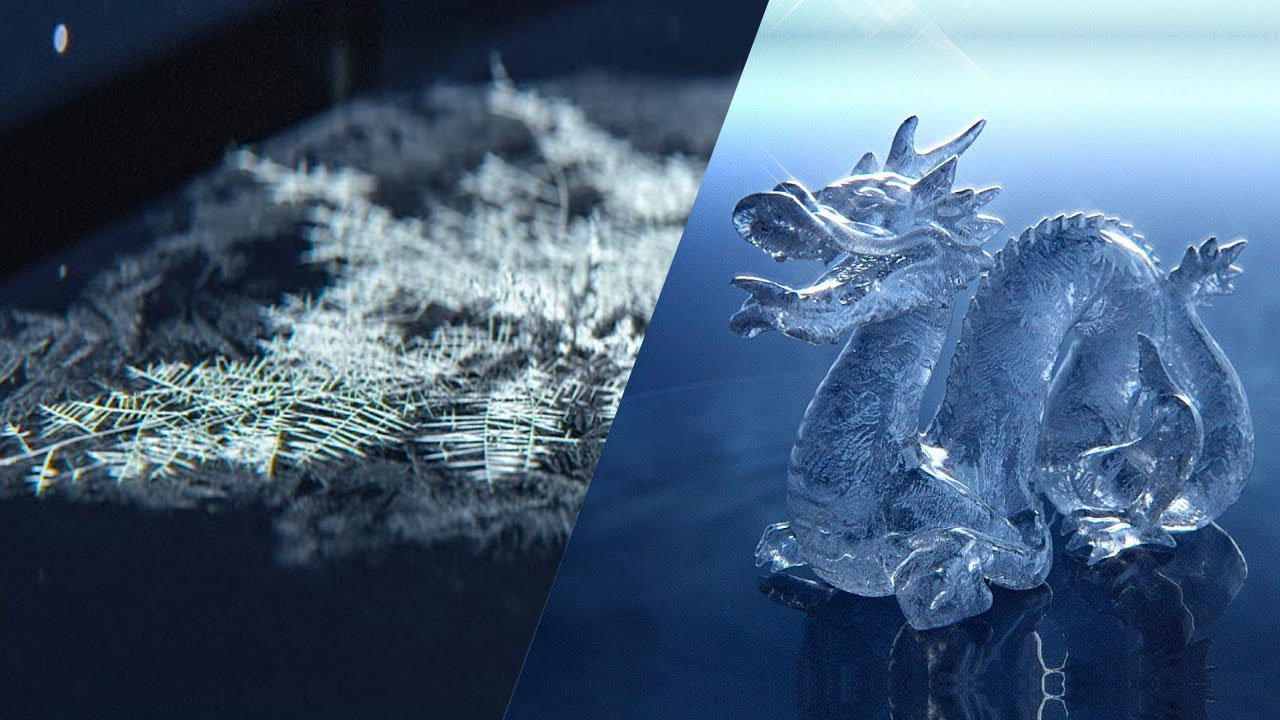
Procedural Growing Frost Cinema 4D & X-Particles + Creating a Realistic Ice Material in Arnold 5
Daniel Danielsson is a Freelance Director / Motion Designer who is based in Hertfordshire, which is north of London, England. I'm not sure how much snow and ice they get there, but Daniel has some fantastic Cinema 4D tutorials on creating frost and ice.
More...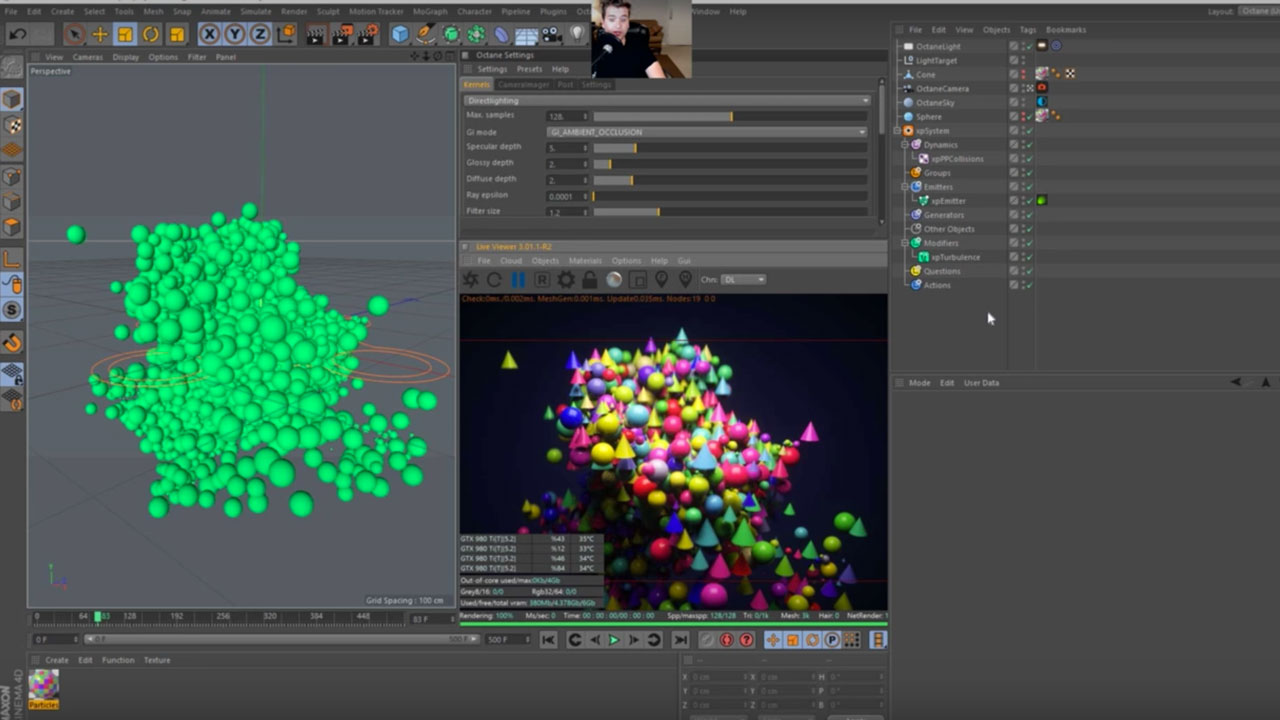
Working With Octane’s Random Color Shader and X-Particles
Learn how to use the random color shader in Octane so that it works with X-Particles, giving you a unique color for each particle in a group.
More...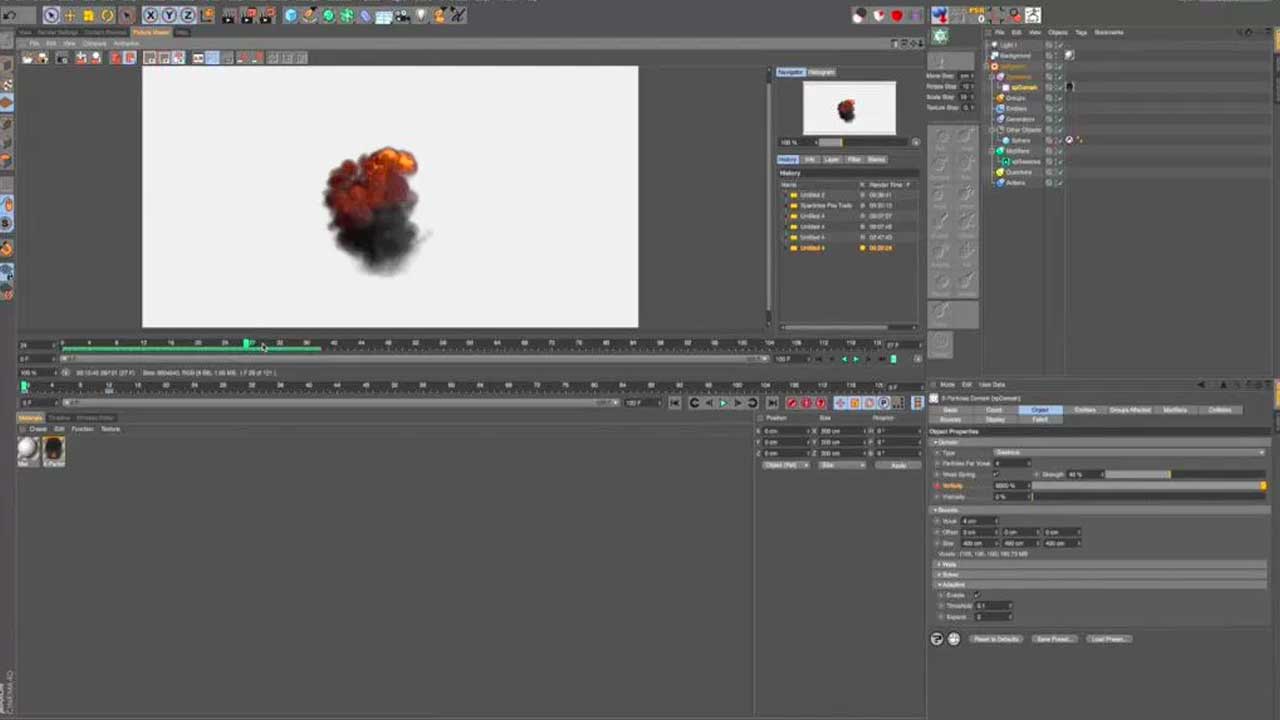
X-Particles Explosions in Cinema 4D
Noah Witchell has a tutorial on making a fiery explosion using the FLIP Solver, which is built into X-Particles.
More...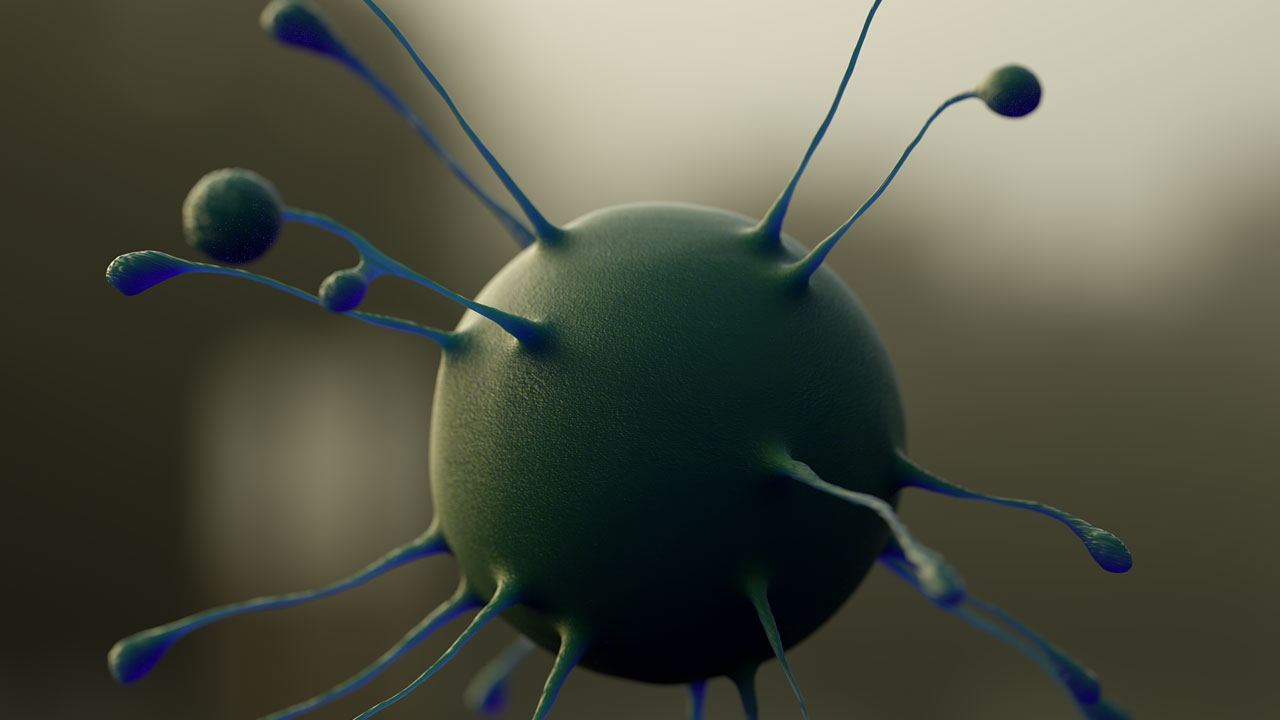
Creating an Abstract Tentacle Creature with X-Particles and Octane
“As I was creating one of my daily renders I came up with a technique to create an abstract tentacle sea creature using X-Particles in Cinema 4D.” - LockedAndLoading
More...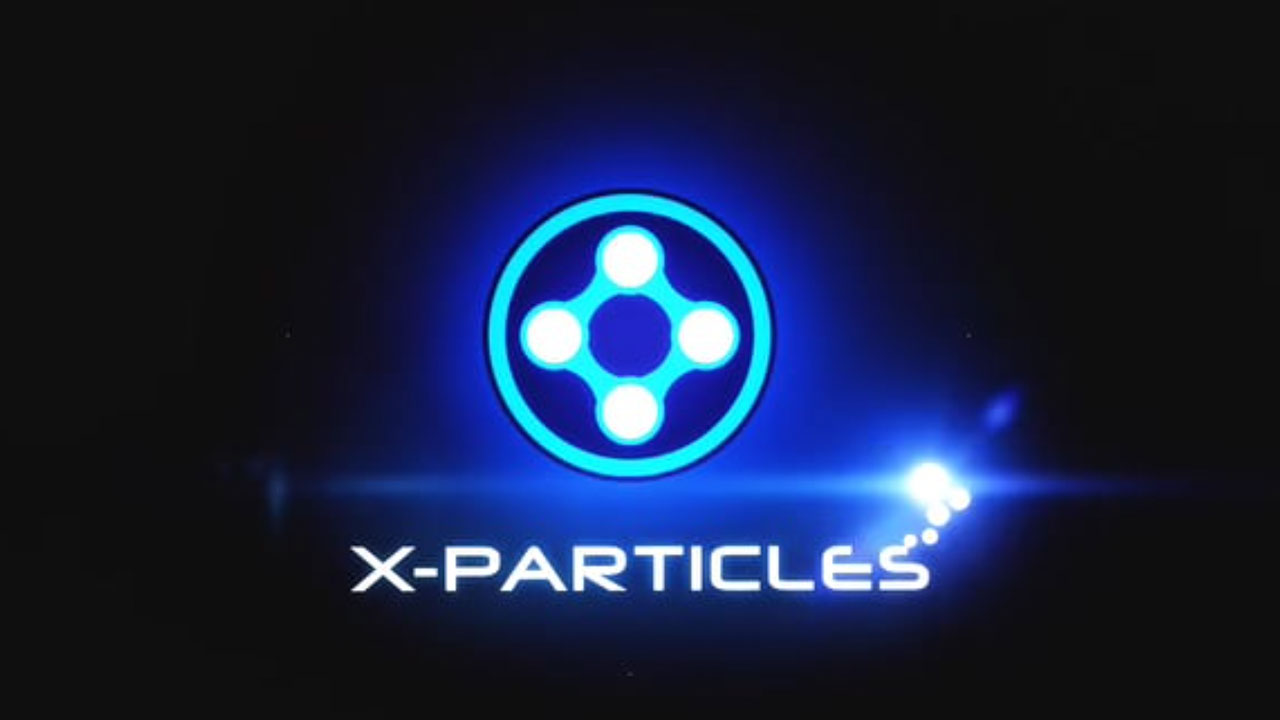
Creating Fireworks with X-Particles
Make sparks fly, well fireworks rather, in one of the many great tutorials from INSYDIUM!
More...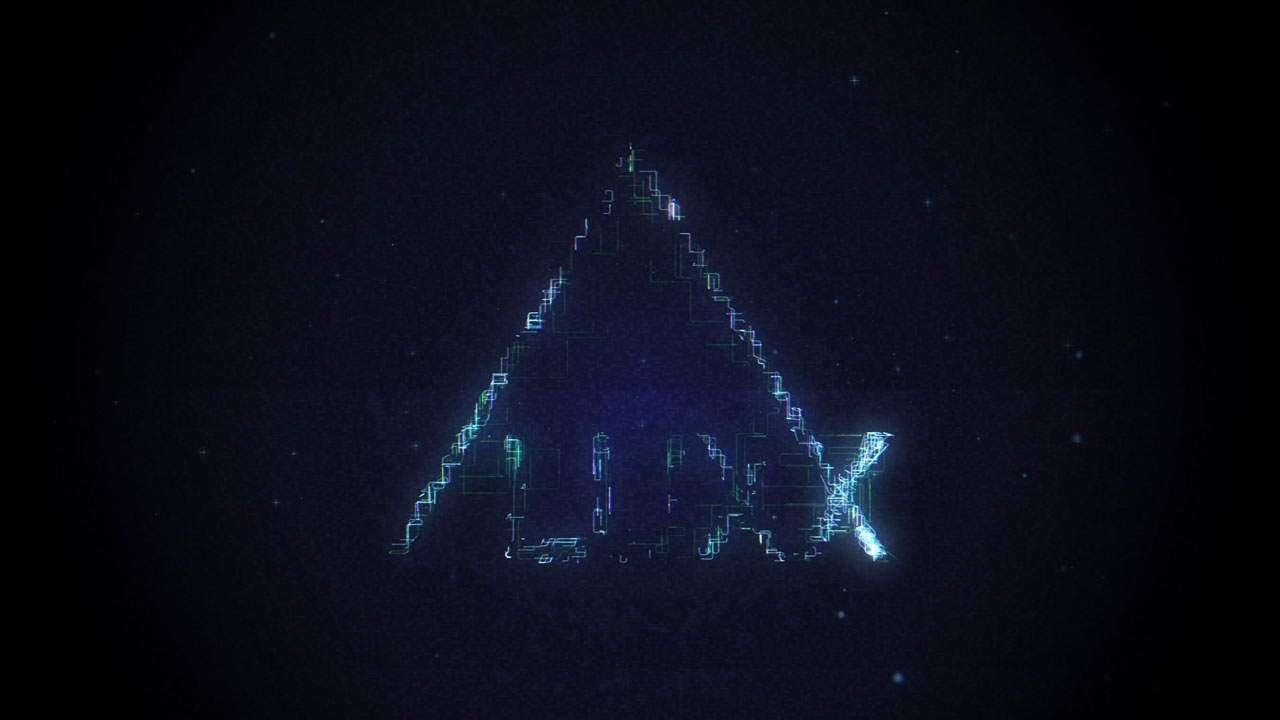
Logo Reveal with X-Particles
Starting with a simple polygon object, Tim Clapham of helloluxx takes you through the entire process on how to create a logo reveal with X-Particles in Cinema 4D
More...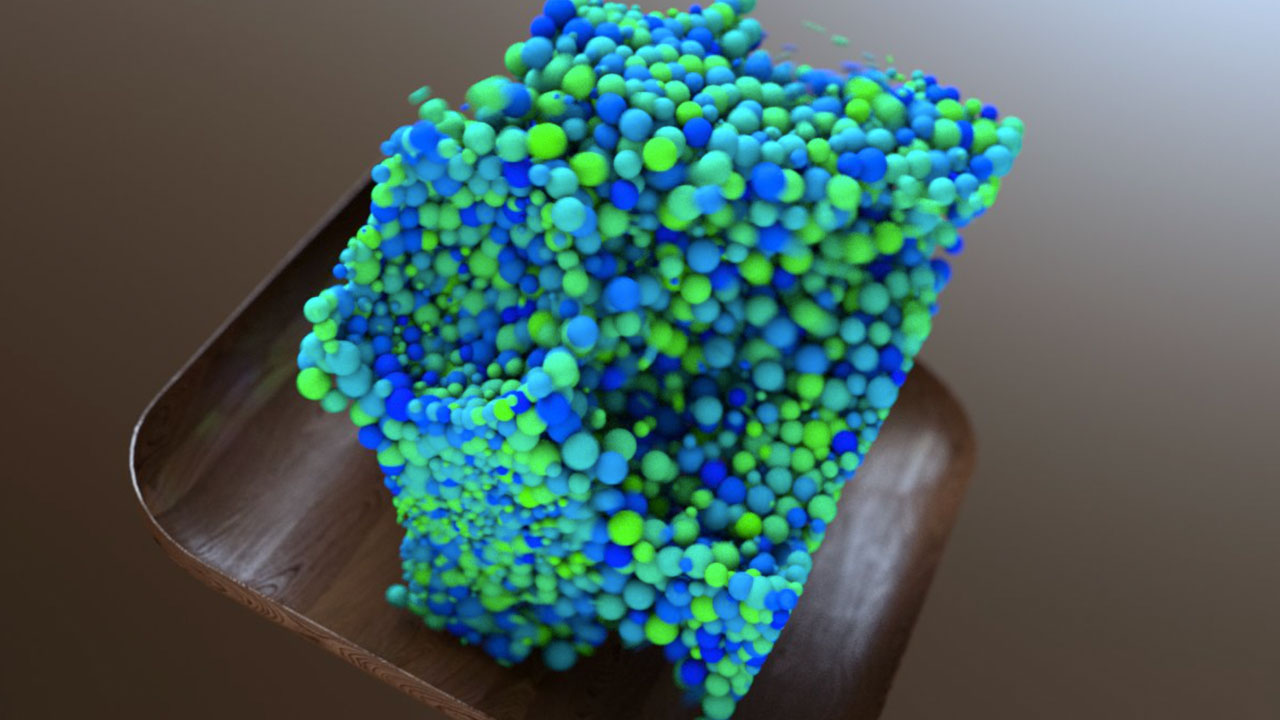
X-Particles & Octane in Cinema 4D
This is supposed to be a basic introduction of how to render X-Particles in Octane for Cinema 4D.
More...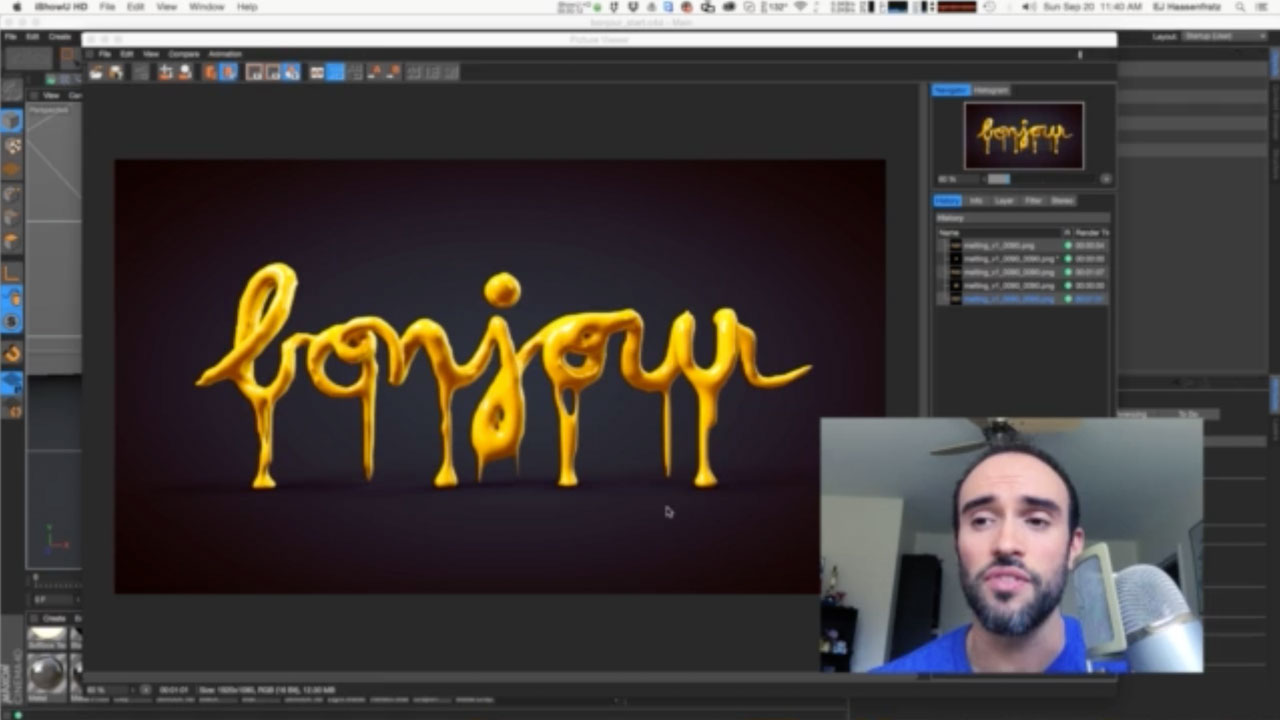
Melting Effect with x-particles by EJ Hassenfratz
Who says tutorials can only be shared on Tutorial Tuesday?! EJ Hassenfratz has kind enough to provide us with this great tutorial on creating a melting effect with x-particles!
More...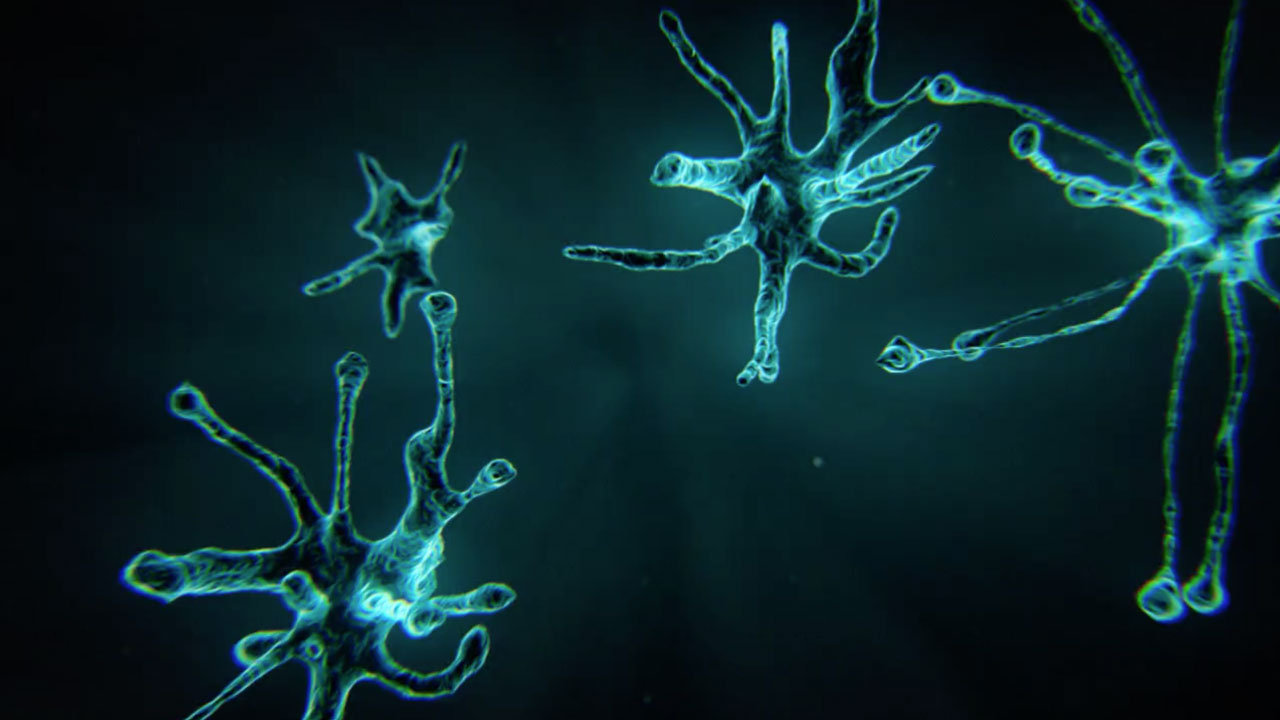
Growing Neurons / Dendrites Using X-Particles in Cinema 4D
Learn how to create and animate dendrites, or neuron like cels using X-Particles in Cinema 4D.
More...
Soft Bodies with X-Particles in Cinema 4D
helloluxx offers up this tutorial on how to simulate soft bodies using X-Particles 3 in Cinema 4D.
More...
Creative Type with Cinema 4D Hair, MoGraph & X-Particles
Follow along in this great tutorial from helloluxx and you will learn how to make all sorts of beautiful new type in Cinema 4D!
More...2D Splash Effects with X-Particles
Mattias Peresini shows how to use X-Particles for CINEMA 4D to quickly create parametric splash and trails, with homage to the classic look of 2D cell animation. The tutorial is in English and French.
More...Particle Advection X-Particles With Turbulence FD Fluids
Lester Banks always serves up fine content on his blog and here's another via Lester. We first linked to this one in February 2014, but here it is again if you missed it.
More...Introduction to Explosions Using X-Particles and Turbulence FD
Josh Johnson from VFXDaily.com makes explosions in CINEMA 4D using X-Particles to drive the Turbulence FD Fluids.
More...Make a Tornado with X-Particles
Mike Batchelor explains how to create a tornado rig with X-Particles.
More...Dynamics Fake with X-Particles
Mike Batchelor explains how to use X-Particles constraints and deformer to create a bouncing, bending motion. It's not true dynamics, hence the name. He uses dynamic springs with constraints and collisions to achieve the effect.
More...Motion Blur for X-Particles
Mike Batchelor shows a couple of ways to create motion blur using X-Particles default material and objects.
More...Nebula Project with X-Particles
Mike Batchelor shows how to create a Nebula structures. He does a great job explaining features of the X-Particles rendering and materials.
More...Intro to Questions and Actions in X-Particles
Learn about Questions and Actions with X-Particles in CINEMA 4D.
More...Intro to Dynamics in X-Particles
Mike Batchelor takes a look at the constraints (multi physics) and the SPH fluids in X-Particles.
More...Create a Cool Spiral with Sprites Attached with X-Particles
FxChannelHouse shows how to create a twistedly fun effect with X-Particles.
More...Easy Paint Peeling Effects with X-Particles Fragmenter
Mike Batchelor uses the X-Particles Fragmentor Object to create peeling effects.
More...Intro to the Fragmenter in X-Particles
The Fragmenter has the ability to turn any objects faces or objects into controllable particles.
More...Corrosion Effect with X-Particles
Mike Batchelor shows how to create a corroded look in CINEMA 4D, using features in the X-Particles Emmitter, Skinner and Cache Object features.
More...Introduction to the X-Particles Skinner
Mike Batchelor's quick start guide to the Skinner. The skinner features a powerful mesher object that can use several particle sources: X-Particles, standard CINEMA 4D emitter, Thinking Particles. It can also use scene objects, completely replacing the CINEMA 4D metaball, to work in conjunction with the fluid system.
More...X-Particles 2.5 Fluids and Foam
Here's a look at the new fluids system in v2.5 of X-Particles and how they use the core SPH fluids.
More...Intro to the X-Particles Emitter
The screaming fast emitter in X-Particles allows for an unbelievable maximum particle count of 1 billion particles! Some of the features are covered in tutorials below are:fluid simulation with wet map generationmultiphysics constraintscollision engineMike Batchelor of slouchcorp.com is an expert in X-Particles so you'll be seeing his name here a lot. He does tutorials on his own and for INSYDIUM LTD, the maker of X-Particles. He put together six basic quick start guides on some of the X-Particles features to get you started with X-Particles.
More...Particle Advection X-Particles With Turbulence FD Fluids
Not only did Mike Batchelor teach me how to create a beautiful particle animation with X-Particles for CINEMA 4D by using fluid created with Jawset Turbulence FD to drive their motion, but I learned what the word ‘advection’ means!
More...Creating Turbulent Fluid Effects Using X-Particles for CINEMA 4D 4D
This tutorial will teach you how to create ink drop like fluid effects using X-Particles for CINEMA 4D 4D.
More...


